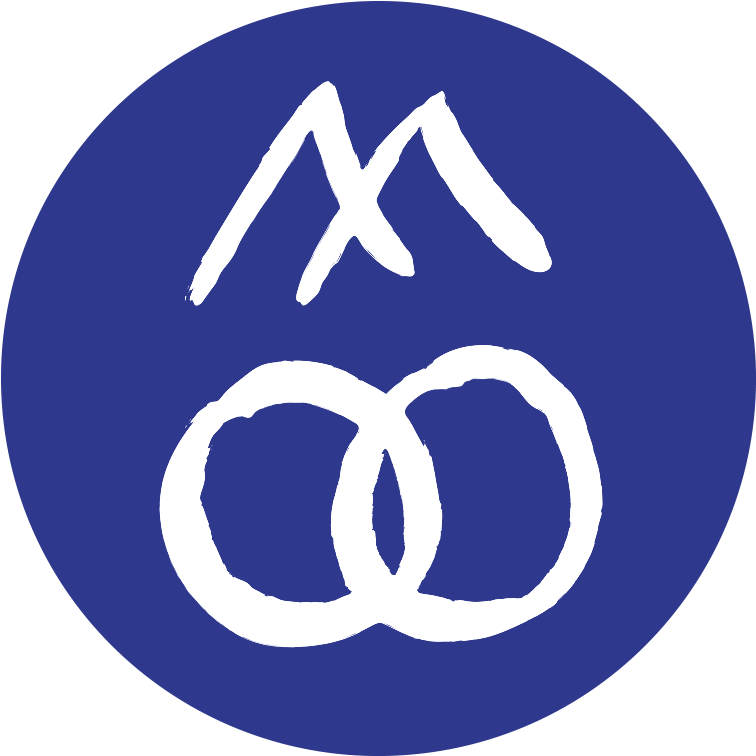(Model study for Nong Pho community’s foreign labours)
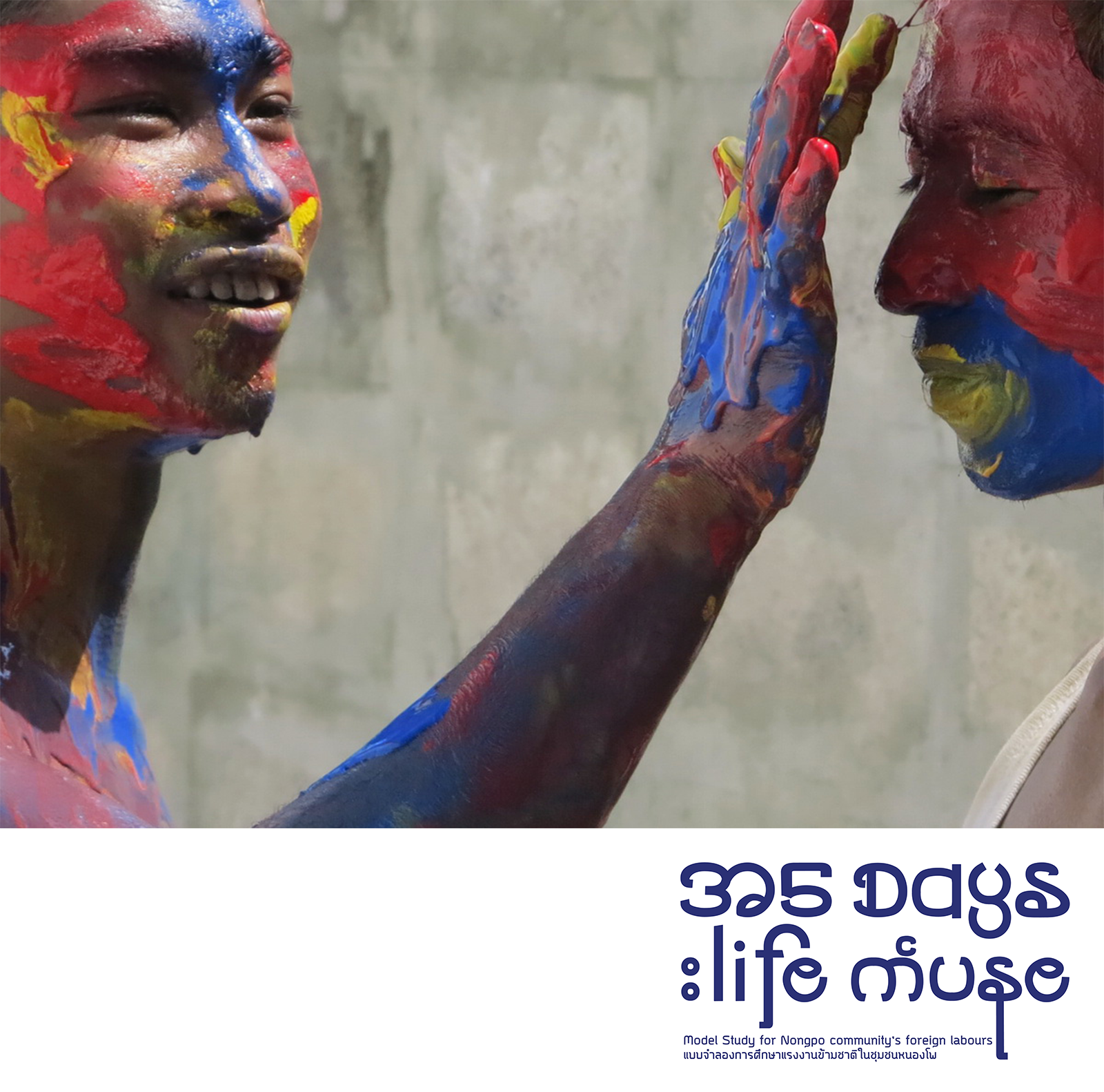
Artists in residency for Artistic Research Project & Contemporary Art Exhibition
365 Days : LIFE MUSE
(Model Study for Nongpho Community’s Foreign Labourers)
365 Days : LIFE MUSE (Model study for Nongpho community’s foreign labourers) is DAY OFF LABoratory#2/2016, an interdisciplinary and collaborative art project co-organized by Art Centre Silpakorn University and Baan Noorg Collaborative Arts and Culture, 2015-2016. There are 22 artists and researchers – Thailand based, Asean and international from 11 countries, participated in the project. Its main programs include: Residency program in Nongpho community, Artist talk program, Exhibition & Forum at the Art Centre of Silpakorn University, Bangkok.
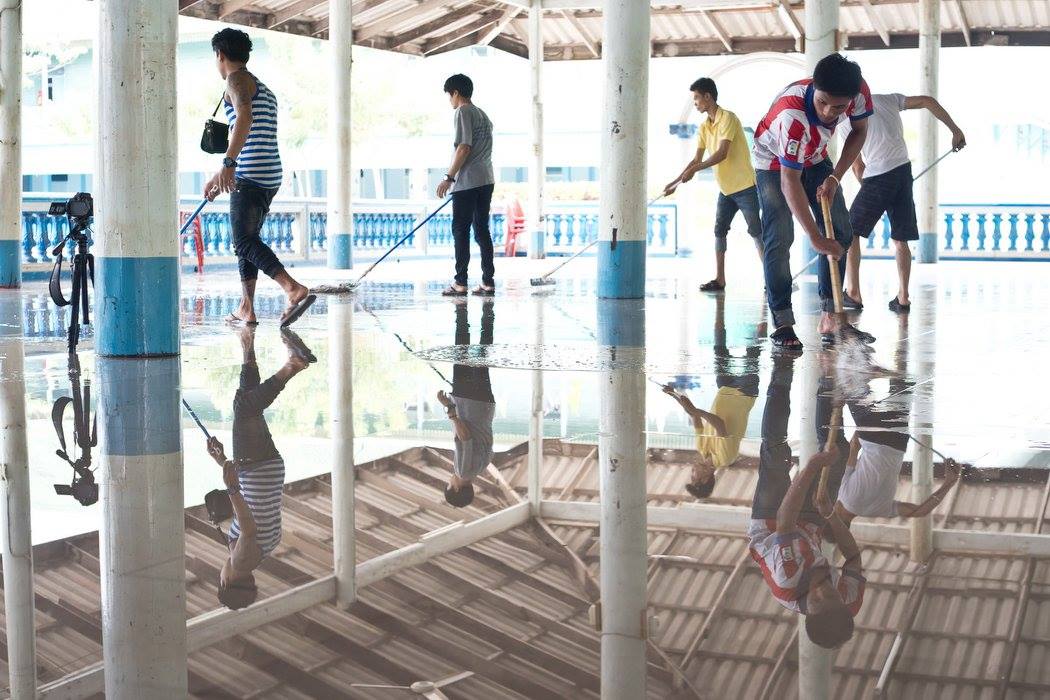
365 Days : LIFE MUSE project aims to be an artistic platform that generate understanding and awareness among human while living in multi-cultural sphere, under “the non-multiculturalism of the multiculturalism” issue. The project open called and invited one Myanmar couple who are foreign labourers in Nongpho community to participate and live in project’s residence for one year. Over 365 days, participated artists have developed alternative learning process, diverse forms of collaborations with the Myanmar couple. There are 10 sessions of artist in residence where each 2 artists are accommodated to develop work or research development within 3 weekends.
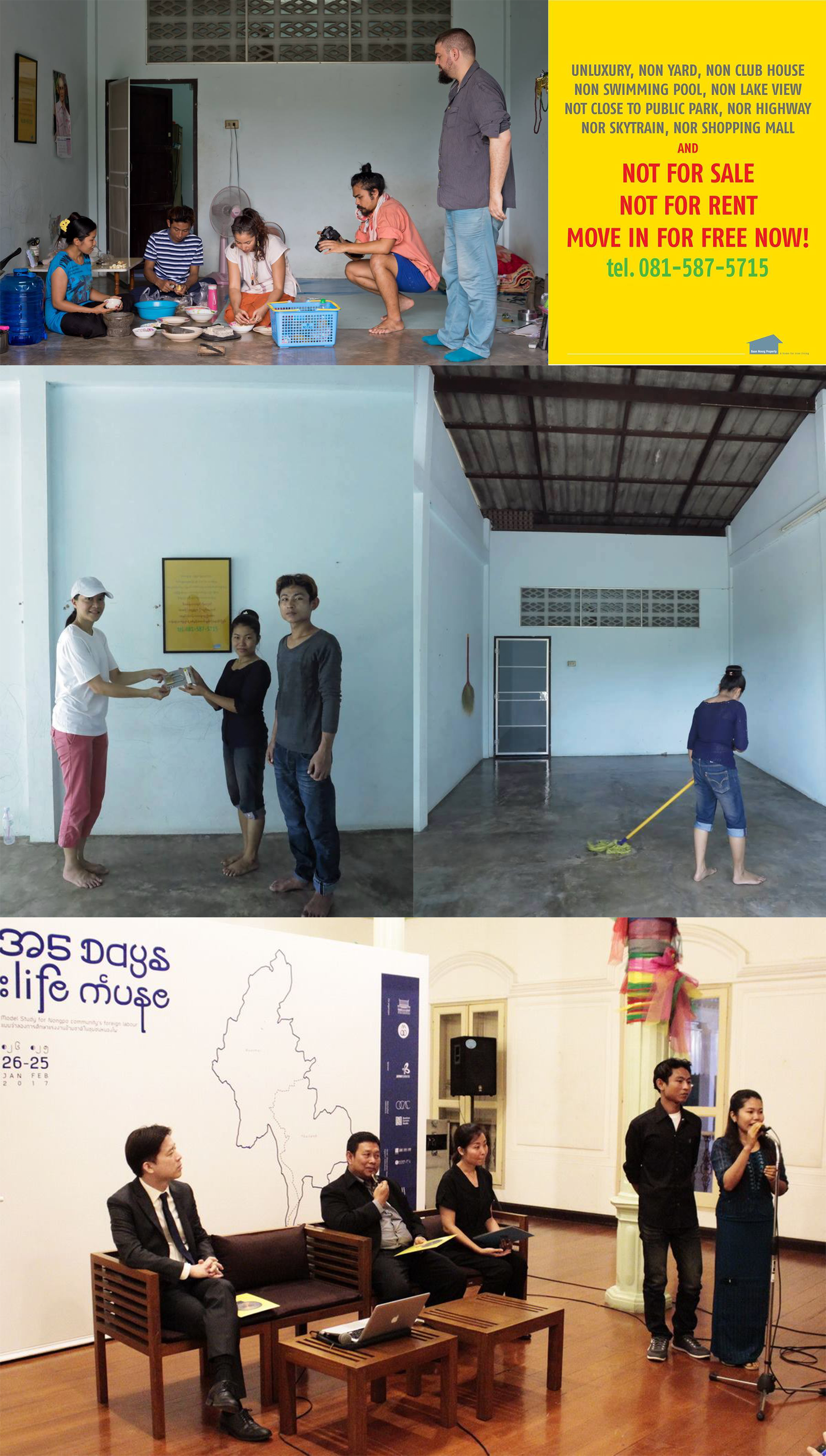
Exhibition Period : 26 Jan- 25 Feb 2017
Venue : Art Centre Silpakorn University, Bangkok, Thailand
Curators: jiandyin (Jiradej and Pornpilai Meemalai)
Assistant Curator: Suphitchaya Khunchamni
Project mapping
Chaw Su and Kyaw Moe (MM)
Invited artists
Chi Yu Wu/ artist represented by Bamboo Curtain Studios (TW)
Chia Jen Chen/ artist represented by Open Contemporary Art Center (TW)
Helmi Hardian, Tuwis Yasinta, artists represented by WAFT-LAB (ID)
Henry Tan (TH)
Jutamas Buranajade & Piti Amraranga (TH)
Katherine Nunez/ artist represented by 98B COLLABoratory (PH)
Korakrit Arunanondchai (TH)
Ma Ei (MM)
Masaru Iwai (JP)
Maung Day (MM)
Okui Lala (MY)
Preenun Nana (TH)
Rachan Klomklieng (TH)
Suraporn Lertwongpaitoon (TH)
Thatchatham Silsupan (TH)
Varsha Nair (IN)
Researchers
Jeanette Mueller and Paul Divjak (AT)
Sebastien Tayac (FR)
Alfred Banze (DE)
Project Directors : jiandyin (Jiradej and Pornpilai Meemalai)
Project Manager : Suphitchaya Khunchamni
Project Assistant managers : Thanet Subsart, Kitiwan Saneewong
Baan Noorg’ board committees : jiandyin, Sakarin Krue-On, Lo Shih Tung and Hsu Chia Wei
Project initiator : Baan Noorg Collaborative Arts and Culture
Co-organizers: Art Centre Silpakorn University / Baan Noorg Collaborative Arts and Culture
Associated institutions : Bamboo Curtain Studios, Taipei, Open Contemporary Art Center (OCAC), Taipei
Official support : Art Centre Silpakorn University
Sponsor : Japan Foundation, Bangkok
Accommodation support : PASAYA
Project advisory boards : Pramaha Somkit Adhasittho, Abbot of Nongpo Temple / Suthep Boonprasop Director of Nongpo Temple, Nongpo Temple Community School
Myanmar relations advisor & coordinator: Maung Day
Media partners : Art4D, Fine Art Magazine
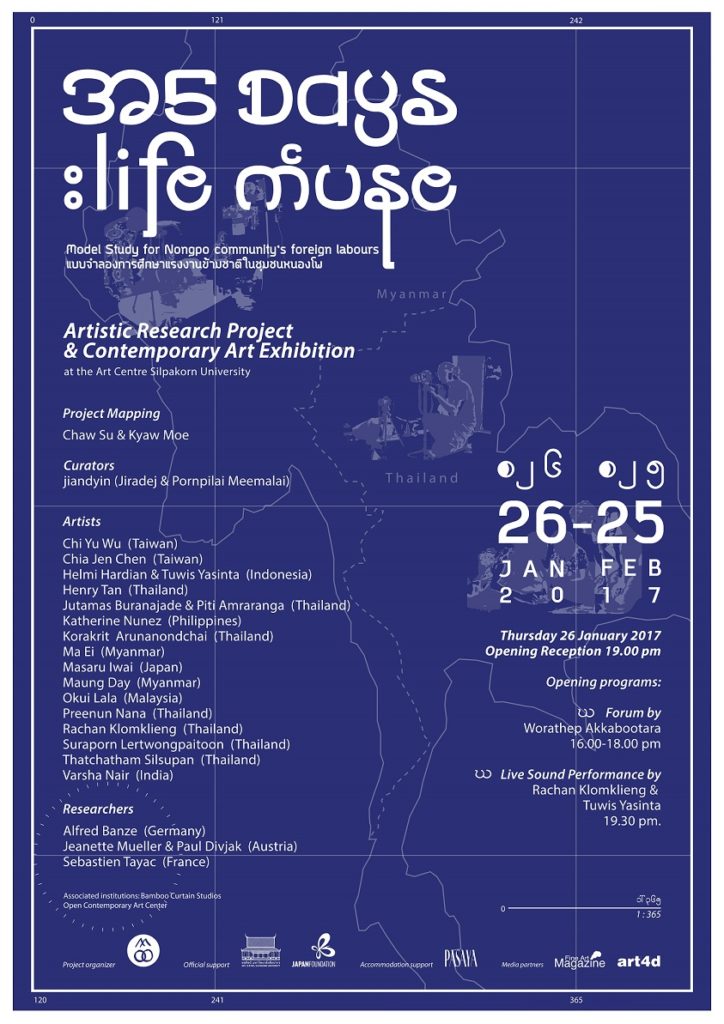
![]() : THE STORIES OF OTHERS
: THE STORIES OF OTHERS
http://art4d.com/2017/04/the-stories-of-others
Bangkok Layers contemporary art exhibition: Catalogue
https://issuu.com/baannoorg/docs/bangkoklayersbybaannoorg2018
365 Days : LIFE MUSE_Teaser 01
https://www.youtube.com/watch?v=r1bSZ0oecD0
365 Days : LIFE MUSE_Teaser 02
https://www.youtube.com/watch?v=MYtMv-YjT58
Live sound performance by Rachan klomklieng vs Hyper Allergic sub (Waft Lab)
https://drive.google.com/file/d/0B-1DUO24JmPZbmhaU0lRNFAtNFE/view?fbclid=IwAR3l1xYH_u_k0DJfMT7bwdfTuC44UFG_7db31mHDlSDlnC5oxbpJxY4pD0o
Artists in residency for Artistic Research Project & Contemporary Art Exhibition
365 Days : LIFE MUSE
(Model Study for Nongpho Community’s Foreign Labourers)
365 Days: LIFE MUSE (Model study for Nongpo community’s foreign labours), an Artists in Residence for Artistic Research and Contemporary Art Exhibition Project has been created with the aim to develop interdisciplinary arts to deliver the message on the vision pertaining the conflict of diaspora and laboured- migration issues and the potentials that these issues could be portrayed through arts. The project has designed collaborative and learning platform including social, humanity-oriented, artistic activities through artworks by 22 Thailand based, ASEAN and international artists and researchers. This is in collaboration with the community and Myanmar labours living in the community and the vicinity in order to address open-end questions over the cultural paradox under the notion of “non-multiculturalism of the multiculturalism”.
Abstract
Sociologists consider that the use of the word “alien labour” implies negative connotation as it denotes an alienated state to the subject. However, the word is adopted in governmental and legal divisions. Since 11 June 2014, the Thai government has generated a solution under 59/2557 order, to appoint Foreign Workers Problem Management Committee to solve the problem from the whole system of foreign labours. It has challenged Thailand’s state policy on the dimension of “Security State” in which social and cultural security concept has affected “Beyond Human Rights”, which means that more emphasis has been put on social attitude and problem analysis rather than on the human right issue. This is to investigate the inter-relationship between State, investment and labours in order to understand the fundamentals of foreign worker’s problem. Instead of focusing on the human rights under the neo-liberalism concept [1] , a development of body of knowledge toward problem management strategy is setup to solve the problems in accordance with the actual situation and the changes happening in the present and in the future. The economists who specialise in migrant and foreign labours have proposed that the migration of foreign labours is a phenomenon coherent to the economic changes, the shifting from agricultural to industrial society while the economic ratio in agricultural sector has been devalued in opposition with the industrial and service areas. Therefore, there are demands for the employment for the working class. The influx of labours reserve from the downfall of agricultural sector were then transferred to the latter. Foreign labours arecorrespondingly the factor of a country’s economic reforming. Almost every developed industrial country’s growth happens through foreign labour system. Hence, labour migration of foreign labours should not be negatively regarded as the migration is beneficial for both labours’ well being and country of destination rather than for the country of origin. The dynamic of political, public administrative, economical, social and cultural reform that is propelled in the society right now allows a chance for us all to reconsider the perception and the debate relating to migration of foreign labours, which has lied in the xenophobia. People are worried for poorly stated reasons feeling insecure when they have to encounter the people from different culture. Xenophobia is similar to racism, which has evoked prejudice toward foreign labours with the belief that they are taking advantage from the country while causing social problems and becoming a burden to the locals having to deal with drugs and crime as well as that their job employment is affected. As a consequence, this antipathy has lead to the demand for the government to come up with policy to strictly control foreign labours and to prevent the overflow of the migrants not to settle down in the country. The day OFF LABoratory program operates annual and launched its first edition in 2013,
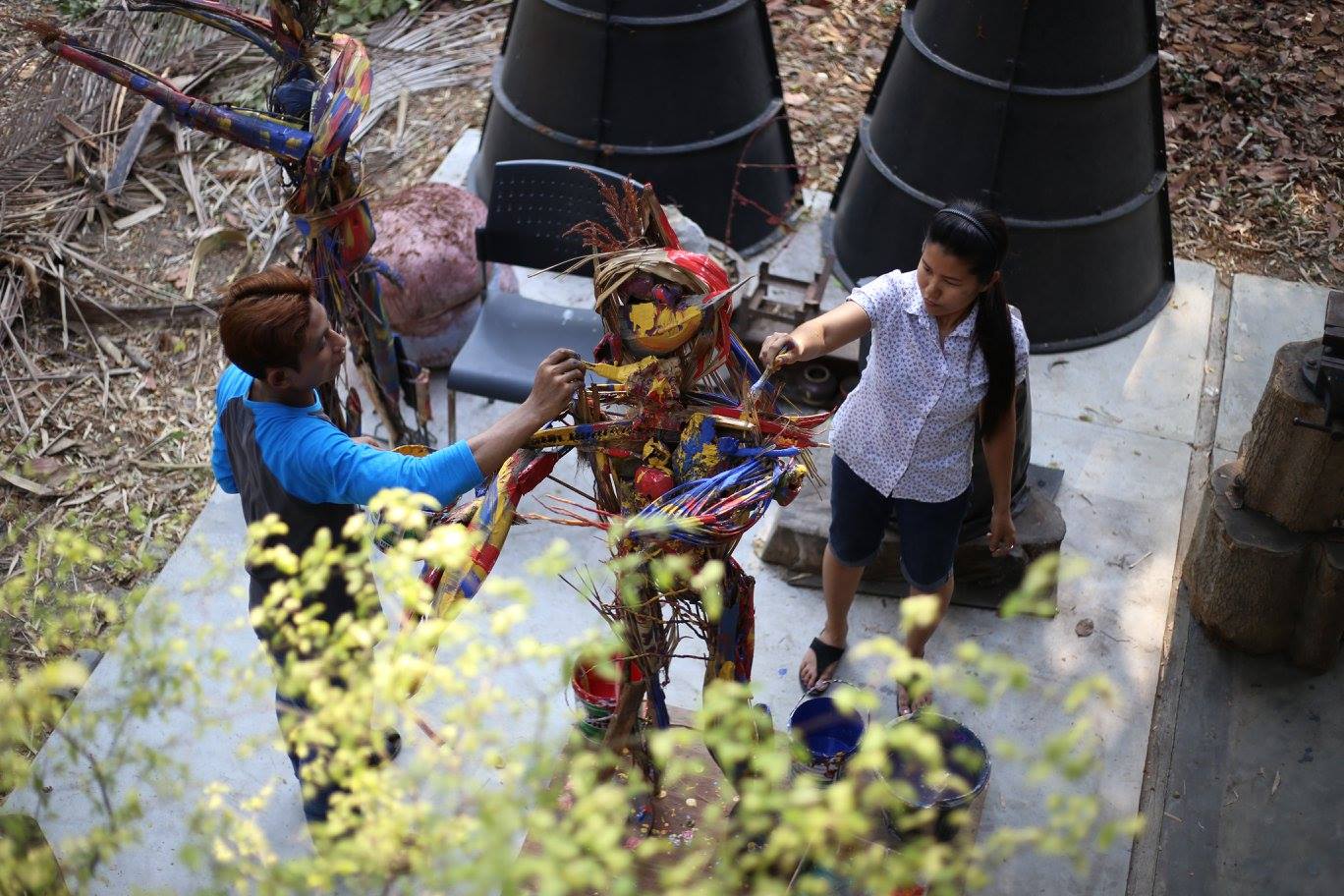
Artists in residence for artistic research and contemporary art exhibition Pop Up Museum (Model Study for Nongpo Community) project, and followed by OFF LAB # 2, Artists in residence for artistic research and contemporary art exhibition 365 days: LIFE MUSE (Model Study for Nongpo Community’s Foreign Labours) project. This is a one- year project from 2015 to 2016, which is an ongoing project with an aim to generate learning process, reduce the gap of cultural diversity and exchange the contemporary art experience amongst international, ASEAN and Asian participants with the initiative of a residency program. Thai and international artists from Indonesia, Philippines,
Myanmar, Japan, Taiwan, Malaysia as well as Germany, Austria and France were invited to stay in the community, developed artistic research and artworks with community members and the Myanmar labours who reside and legally work in Nongpo and the vicinity. The participants have joined and collaborated in the process of project development every two months throughout the course of one-year time. Two artists are invited to develop their work in the community having three weeks on each sessions of residency. This project is originated by Baan Noorg Collaborative Arts and Culture.
The project is supported by Art Centre of Silpakorn University and the Japan Foundation, Bangkok in association with many institutions within the community and from abroad : Open Contemporary Art Center, Taipei, Bamboo Curtain Studio, Taipei, Taiwan, 98B COLLABoratory, Manila, Philippines, WAFT LAB, Surabaya, Indonesia, Nongpo Temple, Nongpo Temple Community School and Nongpo District community members. The result of the artistic-research, the contemporary art exhibition, live performance and forum for 365 Days: LIFE MUSE (Model study for Nongpo community’s foreign labours) are held at the Art Centre of Silpakorn University, Thapra campus Bangkok and the experimental space of Baan Noorg Collaborative Arts and Culture, Nongpo District, Ratchaburi.
[1] Thailand Transnational Migrant Labour Management Policy : From Xenophobia to (Beyond) Human Rights, Preuk Taotawin, Journal of Mekong Societies, 6, 3 (September-December 2010) : 11
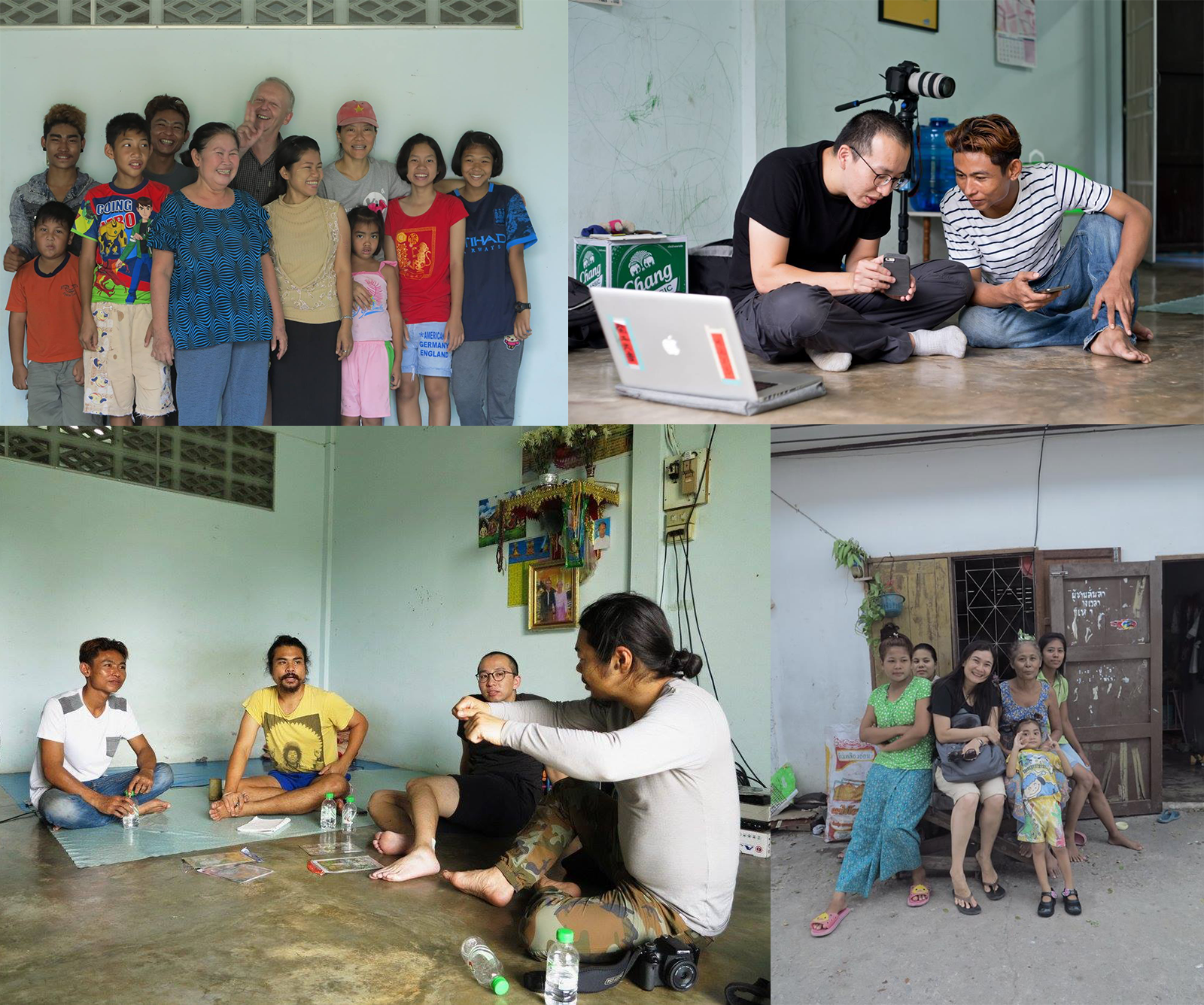
โครงการศิลปินในพำนักเพื่อการศึกษาวิจัยเชิงทัศนศิลป์ และนิทรรศการศิลปะร่วมสมัย
365 Days: LIFE MUSE (กรณีศึกษาแรงงานข้ามชาติชุมชนหนองโพ)
365 Days: LIFE MUSE (การศึกษาแบบจำลองแรงงานข้ามชาติในชุมชนหนองโพ) โครงการศิลปินในพำนักเพื่อการศึกษาวิจัยเชิงทัศนศิลป์และนิทรรศการศิลปะร่วมสมัย มีเป้าหมายในการพัฒนาสหวิทยาการศิลป์เพื่อนำเสนอวิสัยทัศน์และศักยภาพในประเด็นความขัดแย้งของการอพยพโยกย้ายถิ่นฐานและการเคลื่อนย้ายแรงงาน โครงการได้ออกแบบพื้นที่กิจกรรมการเรียนรู้และความร่วมมือด้านทัศนศิลป์ สังคมศาสตร์ มนุษยศาสตร์ ฯลฯ ผ่านผลงานสร้างสรรค์โดยศิลปินและนักวิจัยเชิงทัศนศิลป์ 22 ท่าน ทั้งไทยและนานาชาติร่วมกับชุมชนและแรงงานข้ามชาติชาวพม่าในชุมชนและพื้นที่ใกล้เคียง เพื่อตั้งคำถามปลายเปิดบนความย้อนแย้งทางวัฒนธรรมภายใต้แนวคิดความหลากหลายที่ไม่หลากหลายทางวัฒนธรรมร่วมสมัย
บทนำ
นักสังคมศาสตร์มีความเห็นว่า การใช้คำว่า “แรงงานต่างด้าว” มีนัยยะเชิงลบเป็นคำที่ใช้กันในวงการกฎหมายและวงราชการ เนื่องจากแรงงาน ต่างด้าว ตรงกับภาษาอังกฤษว่า alien labour ซึ่งอธิบายภาพสถานะของสิ่งที่มาจากต่างดาว แสดงความเป็นอื่นนอกเหนือไปจากความเป็นมนุษย์ แนวโน้มการแก้ปัญหาของภาครัฐโดยออกคำสั่ง ฉบับที่ 59/2557 เมื่อวันที่ 11 มิ.ย.2557 โดยการแต่งตั้งคณะกรรมการนโยบายการจัดการปัญหาแรงงานข้ามชาติ หรือ กนร. เพื่อแก้ไขแรงงานข้ามชาติทั้งระบบท้าทายต่อนโยบายรัฐไทยในมิติ “รัฐความมั่นคง” (Security State ) แนวคิดความมั่นคง สังคม และวัฒนธรรม ส่งผลต่อแนวคิด “เหนือกว่าสิทธิมนุษยชน” (Beyond Human Rights) ซึ่งหมายถึงการให้ความสำคัญต่อท่าทีและบทวิเคราะห์ปัญหาในระดับที่เหนือกว่าหรือก้าวไปไกลกว่าเรื่องสิทธิมนุษยชน โดยมุ่งตรวจสอบความสัมพันธ์ระหว่าง รัฐ ทุน และแรงงาน เพื่อเข้าใจตรรกะพื้นฐานของปัญหาแรงงานข้ามชาติ เพื่อจะได้แก้ไขปัญหาที่รากฐานจริงๆ แทนที่จะเสียเวลาไปสนใจเรื่องสิทธิมนุษยชนในแนวคิดลัทธิเสรีนิยมใหม่ [1] ด้วยการกำหนดทิศทางการพัฒนา และกำหนดนโยบายยุทธศาสตร์การพัฒนาองค์ความรู้ในการบริหารจัดการปัญหาให้สอดคล้องกับสถานการณ์ และการเปลี่ยนแปลงในปัจจุบันและอนาคต นักเศรษฐศาสตร์ผู้เชี่ยวชาญเรื่องการย้ายถิ่นและแรงงานข้ามชาติเสนอว่า การย้ายถิ่นของแรงงานเป็นปรากฏการณ์ที่ควบคู่กับการปรับเปลี่ยนโครงสร้างทางเศรษฐกิจ โดยการเปลี่ยนแปลงจากสังคมเกษตรกรรมเข้าสู่สังคมอุตสาหกรรมเกิดขึ้นท่ามกลางการลดสัดส่วนมูลค่าทางเศรษฐกิจของภาคการเกษตร ในขณะที่มูลค่าในสัดส่วนของภาคอุตสาหกรรมและบริการเพิ่มขึ้น จึงเกิดความต้องการจ้างงานจำนวนมาก แรงงานสำรองที่ล้นเหลือจากความตกตํ่าในภาคเกษตรถูกโอนย้ายมาเป็นแรงงานในภาคอุตสาหกรรมและบริการมากขึ้น ดังนั้นแรงงานจึงเป็นเสมือนกลไกการปรับตัวทางเศรษฐกิจในประเทศ เราจะพบว่าประเทศอุตสาหกรรมที่พัฒนาแล้วนั้นเติบโตขึ้นด้วยกลไกของแรงงานข้ามชาติจากประเทศอื่นทั้งสิ้น แรงงานข้ามชาติเหล่านี้ได้ช่วยเสริมการเติบโตทางเศรษฐกิจของประเทศนั้น เราไม่ควรมองการย้ายถิ่นข้ามชาติของแรงงานอย่างเป็นลบ เพราะการย้ายถิ่นเป็นประโยชน์ทั้งต่อชีวิตความเป็นอยู่ของแรงงานและต่อเศรษฐกิจของประเทศปลายทางมากกว่าประเทศต้นทาง พลวัตของแนวทางการปฏิรูปโครงสร้างการเมืองการปกครอง เศรษฐกิจ สังคมและวัฒนธรรม ที่กำลังขับเคลื่อนอยู่ในขณะนี้ เป็นโอกาสที่ดีที่เราจะหันมาทบทวนแนวคิดและข้อถกเถียงเรื่องการย้ายถิ่นฐานของแรงงานข้ามชาติในระดับสากล ซึ่งตั้งอยู่บนแนวคิดความเกลียดกลัวคนต่างชาติ (Xenophobia) ด้วยอาการวิตกกังวลของคนในสังคมที่บางครั้งไม่มีเหตุผลแน่ชัด เป็นความรู้สึกไม่มั่นคงปลอดภัยเมื่อประสบกับผู้คนจากสังคมวัฒนธรรมที่แตกต่างไปจากตน ความเกลียดกลัวคนต่างชาตินั้นมีความคล้ายคลึงกับการเหยียดเชื้อชาติ (Racism) ความรู้สึกเช่นนี้นำไปสู่อคติต่อแรงงาน โดยมองว่าแรงงานข้ามชาตินั้นเข้ามาหาผลประโยชน์จากประเทศของตน ในขณะที่สร้างปัญหาและภาระแก่ประเทศตนเช่น แย่งงานคนในท้องถิ่น ปัญหายาเสพติดและอาชญากรรม การแทรกแซงทางสังคมและวัฒนธรรมของท้องถิ่น ก่อให้เกิดภาระด้านประชากรสวัสดิการสังคมและความมั่นคงของชาติ สิ่งที่ตามมาจากความรู้สึกที่เป็นลบเช่นนี้ก็คือการเรียกร้องให้ภาครัฐมีนโยบายควบคุมแรงงานข้ามชาติอย่างเคร่งครัด และการกีดกันไม่ให้คนเหล่านั้นเข้ามามากเกินไปและมาลงหลักปักฐานถาวรในประเทศของตน
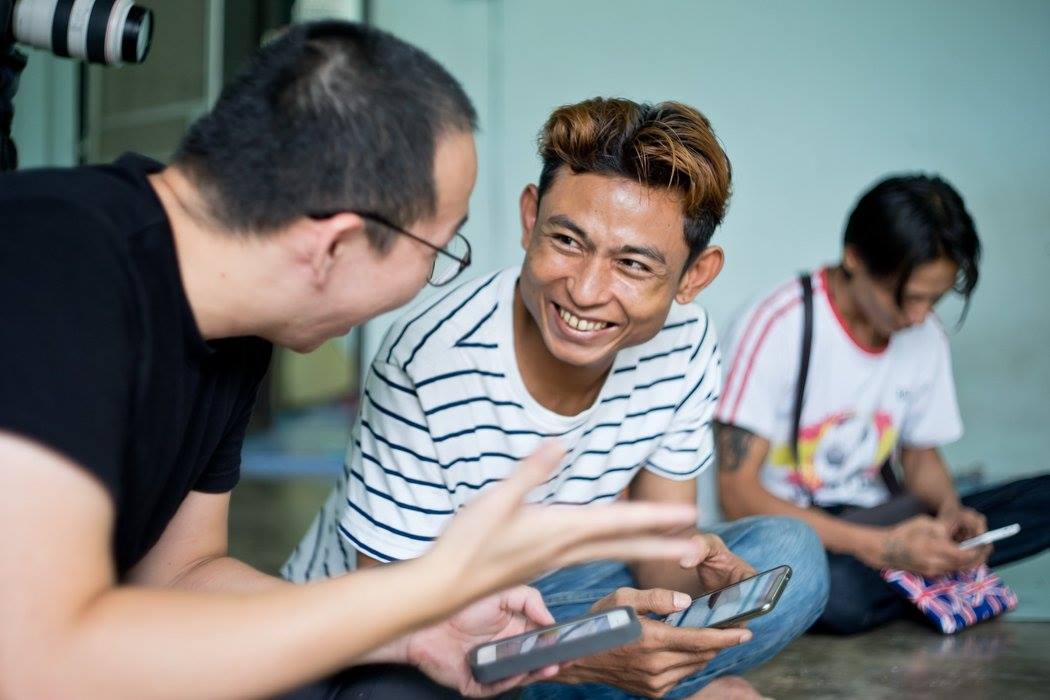
โปรแกรม วันหยุดเรียน (days OFF LABoratory) ดำเนินกิจกรรมโครงการในกรอบเวลาประจำปี มีโครงการในปี พ.ศ. 2557 คือโครงการศิลปินในพำนักเพื่อการศึกษาวิจัยเชิงทัศนศิลป์และนิทรรศการศิลปะร่วมสมัย พิพิธภัณฑ์เฉพาะกาล (กรณีศึกษาชุมชนหนองโพ) ต่อเนื่องในปี พ.ศ. 2558 โปรแกรม วันหยุดเรียน (OFF LAB) ดำเนินโครงการที่ 2 คือโครงการศิลปินในพำนักเพื่อการศึกษาวิจัยเชิงทัศนศิลป์และนิทรรศการศิลปะร่วมสมัย 365 days : LIFE MUSE (การศึกษาแบบจำลองแรงงานข้ามชาติในชุมชนหนองโพ) ระยะเวลา 1 ปี ตั้งแต่ปี พ.ศ. 2558 – 2559 เป็นโครงการต่อเนื่องที่มีวัตถุประสงค์ในการเรียนรู้และลดช่องว่างความต่างทางวัฒนธรรม และการแลกเปลี่ยนประสบการณ์ด้านศิลปวัฒนธรรมร่วมสมัยระหว่างนานาชาติ ในภูมิภาคอาเซียน และเอเชีย การริเริ่มโครงการศิลปินในพำนัก (Artist in residency) เชิญศิลปินไทยและนานาชาติ ได้แก่ อินโดนีเเซีย ฟิลิปปินส์ เมียนมา ญี่ปุ่น ไต้หวัน มาเลเซีย และ เยอรมนี ออสเตรีย ฝรั่งเศส เข้าพำนักในชุมชนฯและพัฒนาผลงานวิจัยเชิงทัศนศิลป์และศิลปะร่วมกับสมาชิกในชุมชนและแรงงานข้ามชาติชาวพม่า ผู้มีที่พักอาศัยและทำงานโดยได้รับอนุญาตตามกฎหมายในเขตพื้นที่ชุมชนหนองโพและชุมชนใกล้เคียง เข้าร่วมพัฒนาโครงการตามกรอบการดำเนินโครงการระยะเวลาทุกๆ 2 เดือน ตลอด 1 ปี / แต่ละครั้งศิลปินที่รับเชิญ 2 ท่าน เข้าพำนักและพัฒนาผลงานในชุมชนหนองโพเป็นระยะเวลา 3 สัปดาห์ โครงการริเริ่มและดำเนินงานโดย บ้านนอกความร่วมมือทางศิลปวัฒนธรรม การดำเนินงานโครงการครั้งนี้ได้รับการสนับสนุนด้านงบประมาณจากหอศิลป์มหาวิทยาลัยศิลปากร และเจแปนฟาวน์เดชั่น กรุงเทพฯ และความร่วมมือจากหน่วยงานต่างๆ ภายในชุมชนและต่างประเทศ อาทิ Open Contemporary Art Center ไทเป ประเทศไต้หวัน Bamboo Curtain Studios ไทเป ประเทศไต้หวัน 98B COLLABoratory มะนิลา ประเทศฟิลิปปินส์ WAFT LAB สุราบายา ประเทศอินโดนีเซีย วัดหนองโพ โรงเรียนชุมชนวัดหนองโพ ชาวชุมชนหนองโพ และแรงงานข้ามชาติชาวพม่าในชุมชนหนองโพและชุมชนใกล้เคียง สรุปผลโครงการศึกษาวิจัยเชิงทัศนศิลป์และนิทรรศการศิลปะร่วมสมัย 365 days : LIFE MUSE (กรณีศึกษาแรงงานข้ามชาติชุมชนหนองโพ) การแสดงสดและกิจกรรมเสวนา ณ หอศิลป์มหาวิทยาลัยศิลปากรวังท่าพระ กรุงเทพฯ และ พื้นที่ทดลองบ้านนอกฯ (Baan Noorg experimental space) ตำบลหนองโพ อำเภอโพธาราม จังหวัดราชบุรี
[1] นโยบายการจัดการแรงงานข้ามชาติ. ของไทย : จากความเกลียดกลัวคนต่างชาติ ถึง (เหนือกว่า) สิทธิมนุษยชน, พฤกษ์ เถาถวิล , วารสารสังคมลุ่มแม่น้ำโขง, ปีที่ 6 ฉบับที่ 3 กันยายน-ธันวาคม 2553, หน้า 11
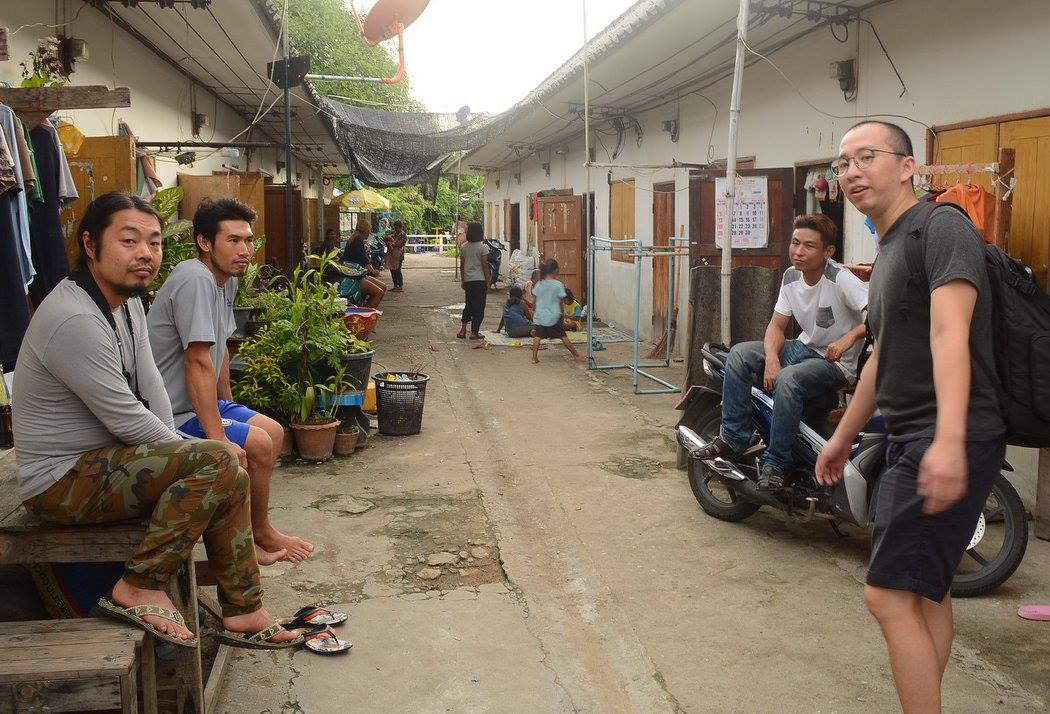
Art After Community
Curatorial Statement: jiandyin (Jiradej and Pornpilai Meemalai)
Arts can act as a vehicle for social change: Moholy-Nagy (1895–1946)
A relation between people is the basis of Participatory and Collaborative Art. But how can artist practically express his/her idea when the boundary of art has been expanded beyond the confined studio, trespasses every borderline and steps into the realm of Sociology, Anthropology and Politics. This extensive practice can bring together the sensitive and fragile issues within our society, which may lead to the possibility of substance or a definition of development of visual arts [1]. However, before slipping into the details, we should firstly question and consider the boundary of art in our society.
The current art does not limit itself only in a private space any longer but unavoidably connects itself with public. Nicolas Bourriaud, a French curator and art theoretician, made a rather poor choice when he used the word ‘relational’ to shed light on a specific segment and tendency in the art world. [2] Actually, there is no limitation on how or in which context art should initiate a conversation about society as long as the artists are rendering their effort in seeking for the connection between art and public and engage themselves in the sociological dialogue. Possessing ambiguity as its true nature, the passion of art to communicate and to participate in order to make an explicit critical conversation is perhaps a merely strong conviction to signal a message to contemporary society where sociability has been disregarded. For the artist who pushes himself toward a complex role by the virtue of artistic ability while decisively concentrates on socio-political subject, his/her work can possibly be defined into auto-relational and allo-relational. These 2 specific tendencies relate to history of modern art in the late 1960s, when art became socio-political movement. The Situationist is a distinct case of the artistic movement that significantly diminished the artistic identity of artwork and the individualistic quality of the artist by shifting the focus to socio-political issues [3]. At the time, the movement had shown its determination in placing importance on other factors outside the retrogressive boundary of the formal art. The characteristic of Community Art, in general, is the art that relates itself to people, leading to the equilibrium between auto-relational and allo-relational art. The first is the community art being planned by the artist and the latter is a reaction toward the participating in the first.
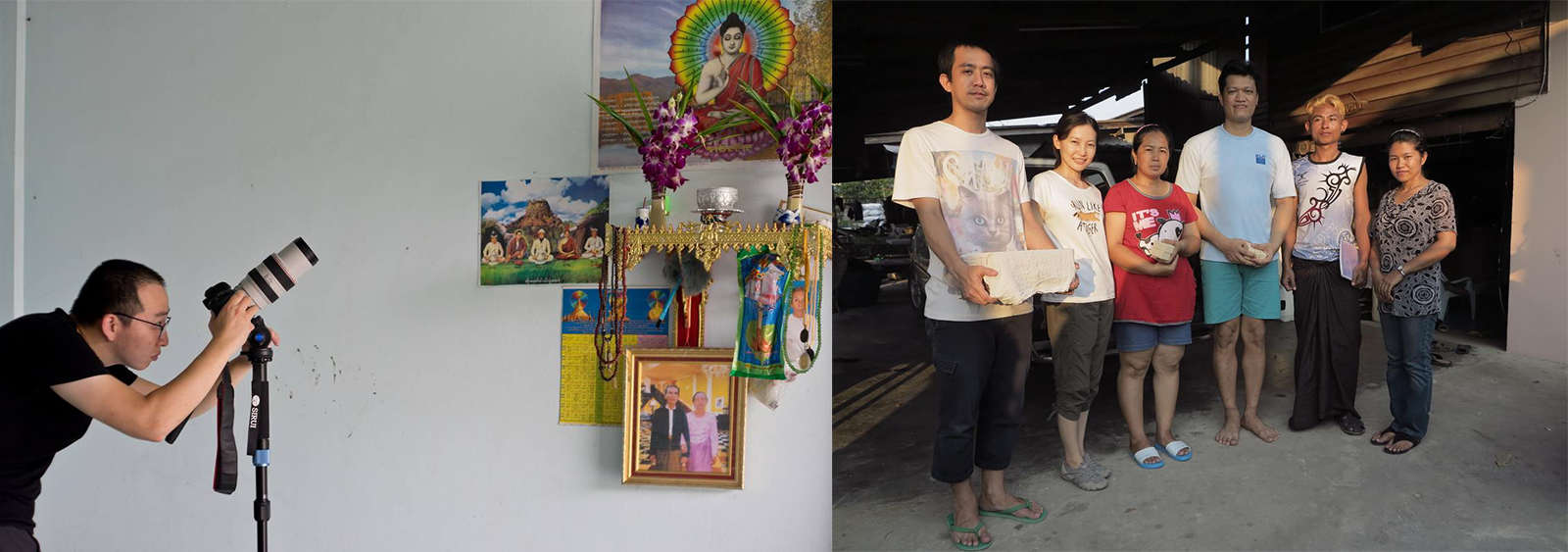
With a broad collaboration of 22 artists and artistic researchers from ASEAN, Asia and Europe, Baan Noorg Collaborative Arts and Culture has presented a sophisticated Aesthetics and Social Science through the project where art activities integrate with researches, field works, artists residency programs, art exhibitions, performances, discussion and open house.. The activities run for 365 days with collaborations between Burmese workers and the community under the practice of art, social and cultural collaboration.
365 Days: LIFE MUSE (Model study for Nongpo community’s foreign labour) aimed to explore, investigate and develop a joint effort of the participants to find the possibility in opening up for initiating a set of social knowledge and experience in transference of research and artistic process. The project also took into account a paradigm shift in the society and culture. All artistic engagements organically proceeded with timing, forms and features that were exposed as artworks in diverse textures: memoirs, videos, photos, drawings, sounds, installations, and sculpture, to create an innovation mirroring the impression of the relationships that has been negotiated throughout the time. A long period of the collaboration was resulting in recognisable changes and adaptations while alternative solutions manifested them accordingly. All of these solutions emphasised the possibility and, at the same time, dissolving a limitation of the existing fragmental artistic knowledge set.
This artistic research and development project applied the process of combination by lower the wall that has separated the community and set it into experimental mode. The project meanwhile unfolding the overlapped fragments to expose the condition of inner space, indicated the meaning of community and explored the value of humanity, all that might be hidden under the regimentation of nation state. The commitment of the artists and the researchers were not decisively stopped at an attempt to engage themselves to public but it involved a confrontation among them. The latter, to a certain extent, produced a parallel role of artists and researchers as paradoxal messengers who would comment on the socio-political context of the program. This made it easier to comprehend that the project partially portrayed aesthetical relationship between a Burmese couple and the community as an artistic practice.
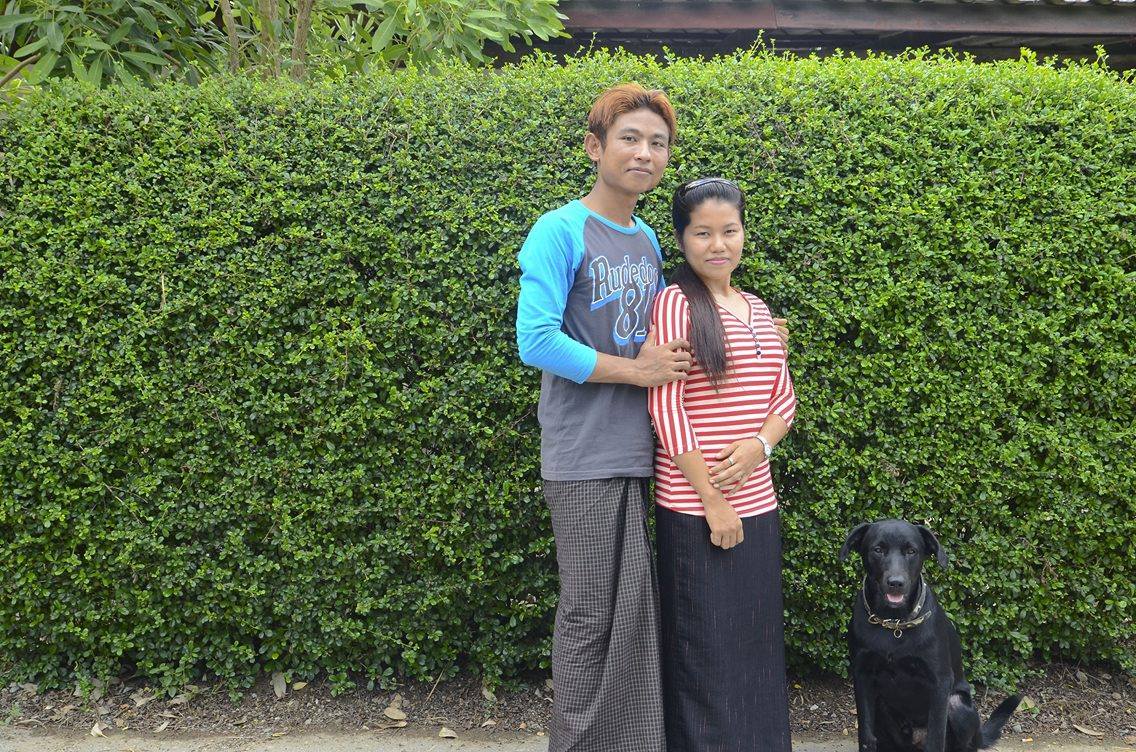
The participation of the Burmese couple was definitely not something that could be overlooked since it played a consequential role as project mapping. The couple were provided with one-year complimentary accommodation and they volunteered to join in the project after finding out the details from the handbill. It was the first time they left their own neighbourhood, a segregated Burmese quarter within Thai community, to live in a house among Thai neighbors. Living in isolation without any interest in engaging with the rest of the community made it impossible for migrant workers to fit in with the host society. As we set the initiative area shared by people of different cultures, we trusted that an attempt to improve the relationship could be done by encouraging dialogues and collaborations among them instead of a confrontation that would lead to an acceptance of diversity and to cultural toleration in the end [4].
[1] Pascal Gielen & Pascal Gielen (eds.) – Community Art, The Politics of Trespassing: 2013, 20.
[2] Pascal Gielen & Pascal Gielen (eds.) :17.
[3] Pascal Gielen & Pascal Gielen (eds.) :19.
[4] Thanet Wongyannawa – The Nonmulticulturalism of the multiculturalism: 2557, 190.
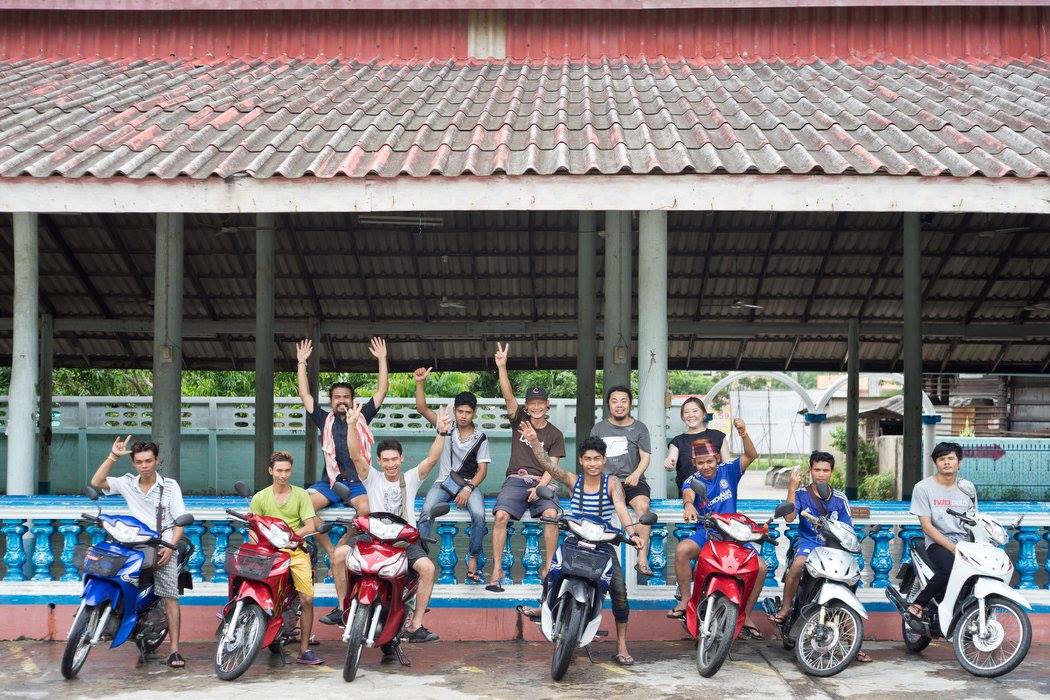
ศิลปะหลังชุมชน
บทภัณฑารักษ์: jiandyin (จิระเดช และ พรพิไล มีมาลัย)
ศิลปะสามารถทำหน้าที่เสมือนพาหนะในการเปลี่ยนแปลงสังคม : โมโฮลี-นากี (1895–1946)
ความสัมพันธ์ของมนุษย์คือหัวใจ และเป็นศูนย์กลางของการทำงานเชิงวัฒนธรรมในแง่มุมศิลปะความร่วมมือและการมีส่วนร่วม(Participatory and Collaborative Art) ในทางรูปธรรมศิลปินจะสามารถแสดงออกอย่างไร เมื่อพื้นที่ทางศิลปะในที่นี้ไม่ได้อยู่ในกรอบอันคับแคบของห้องปฏิบัติงานอีกต่อไป พื้นที่ห้องปฏิบัติงานที่ขยายตัวและข้ามเข้าสู่พื้นที่แวดล้อมอื่นๆ เช่น สังคมศาสตร์ มนุษยศาสตร์ รัฐศาสตร์ ฯลฯ สามารถเชื่อมโยงประเด็นที่ละเอียดอ่อนและเปราะบางทางสังคมเพื่อที่จะนำไปสู่ความเป็นไปได้ของเนื้อหา หรือนิยามในการพัฒนาทางทัศนศิลป์[1] ก่อนที่จะเข้าสู่รายละเอียดเราควรพิจารณาและตั้งคำถามเกี่ยวกับพื้นที่พรมแดนที่ศิลปะดำรงอยู่ในสังคมนี้ ศิลปะมิได้ดำรงอยู่เฉพาะภายในพื้นที่ส่วนบุคคลเท่านั้น แต่มีความสัมพันธ์เชื่อมโยงกับความเป็นสาธารณะอย่างหลีกเลียงไม่ได้ Nicolas Bourriaud ภัณฑารักษ์และนักทฤษฎีศิลป์ชาวฝรั่งเศสได้เลือกใช้คำว่า “relational” ซึ่งเป็นคำจำกัดความที่ยังไม่ตรงนัก สำหรับการอธิบายผลงานของศิลปินบางกลุ่ม ที่พยายามค้นหาเครื่องมือสื่อสารสู่สาธารณะ[2] แท้ที่จริงแล้วมันไม่มีข้อจำกัดว่าศิลปะพูดเกี่ยวกับสังคมอย่างไรหรือบริบทใด ตราบใดที่ศิลปินพยายามค้นหาความเชื่อมโยง-สัมพันธ์ต่อสาธารณะ และร่วมเป็นส่วนหนึ่งในบทสนทนาเชิงสังคม ในฐานะที่ศิลปะมีความคลุมเครือเป็นลักษณะเฉพาะ ความต้องการสื่อสารและการมีส่วนร่วมเพื่อสร้างบทสนทนาเชิงวิพากษ์ที่ชัดเจน อาจเป็นเป้าหมายสำคัญที่จะส่งสารไปสู่สังคมที่ยังขาดแคลนการมีส่วนร่วมและ/หรือบกพร่องด้านการสื่อสารในสังคมร่วมสมัย สำหรับศิลปินที่มีเจตนารมณ์ในการที่จะสร้างตัวบทเชิงสังคม-การเมือง ผลักดันตนเองไปสู่บทบาทที่มีความสลับซับซ้อนโดยอาศัยศักยภาพของตนด้านศิลปะ อาจนิยามด้วยนัยยะสองขั้ว ได้แก่ความสัมพันธ์แบบเป็นไปเองและความสัมพันธ์กับสิ่งอื่น (auto-relational และ allo-relational) ซึ่งมีความเชื่อมโยงกับประวัติศาสตร์ศิลปะสมัยใหม่ช่วงปลายทศวรรษที่ 60 ในหมวดที่การเคลื่อนไหวทางด้านศิลปะกลายเป็นเรื่องสังคม-การเมือง กรณีศึกษาจากการเคลื่อนไหวของกลุ่ม Situationists ได้ลดทอนอัตลักษณ์ของศิลปินหรือความเป็นหนึ่งเดียวเชิงทัศนศิลป์ เพื่อให้ความสำคัญแก่สิ่งอื่นและผู้อื่นนอกเขตแดนอันล้าหลังของศิลปะเชิงเดี่ยวด้วยการให้คุณค่าแก่การเคลื่อนไหวทางสังคม[3] ศิลปะชุมชนโดยทั่วไปมักจะต้องมีลักษณะที่เชื่อมโยงสัมพันธ์กับผู้คน และนำพาไปสู่สมดุลระหว่าง auto- relational และ allo- relational โดยสิ่งแรกคือศิลปะชุมชนที่วางแนวทางโดยศิลปินที่ชำนาญการ และอย่างที่สองคือการสนองต่อปฏิกิริยาการมีส่วนร่วมทางสังคม ด้วยความร่วมมือและการมีส่วนร่วมของศิลปินและนักวิจัยเชิงทัศนศิลป์จำนวนมากกว่า 22 ท่าน จากประเทศอาเซียน เอเชีย ยุโรป บ้านนอกความร่วมมือทางศิลปวัฒนธรรม ได้นำเสนอช่วงเวลาสุกงอมของพัฒนาการทางด้านสุนทรียศาสตร์และสังคมศาสตร์ ด้วยโครงการที่เชื่อมโยงกิจกรรมเชิงทัศนศิลป์ การวิจัย งานปฏิบัติการ ศิลปินในพำนัก นิทรรศการ การแสดงสด การเสวนา กิจกรรมเปิดบ้านฯ ซึ่งดำเนินงานต่อเนื่องระยะเวลา 365 วัน ด้วยความร่วมมือจากแรงงานชาวพม่าและชุมชนหนองโพ ด้วยแนวทางความร่วมมือด้านศิลปะ สังคมและวัฒนธรรม
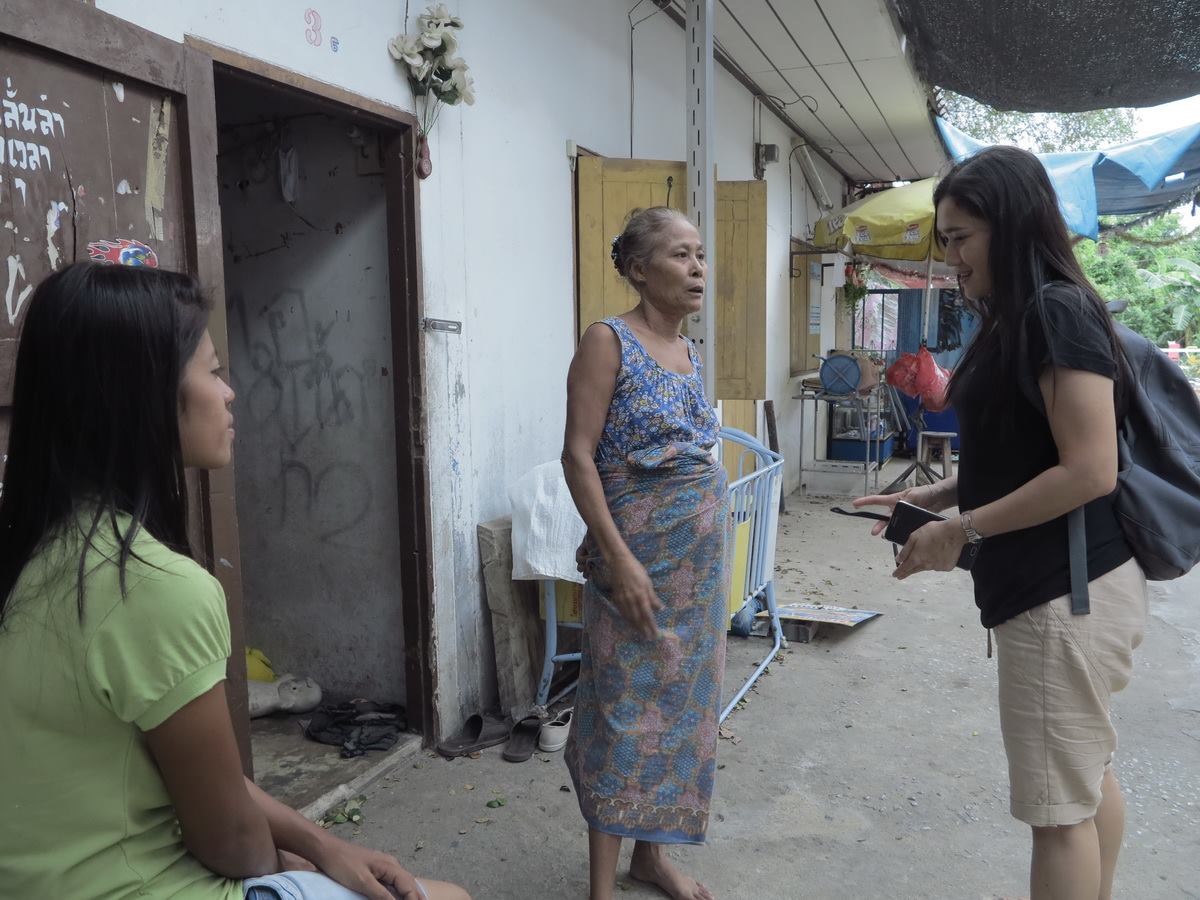
โครงการ 365 Days: LIFE MUSE (กรณีศึกษาแรงงานข้ามชาติในชุมชนหนองโพ) มีเป้าหมายสืบค้น วิจัยและพัฒนา เพื่อแสวงหาความเป็นไปได้ที่จะเปิดกว้างเพื่อสร้างชุดความรู้ทางสังคมและประสบการณ์การเปลี่ยนถ่าย กระบวนการเชิงทัศนศิลป์และงานวิจัยเพื่อพิจารณาถึงการปรับเปลี่ยนกระบวนทัศน์ทางสังคม-วัฒนธรรม ตัวโครงการฯดำเนินงานตามกรอบระยะเวลาอย่างค่อยเป็นค่อยไปในลักษณะออร์แกนิคด้วยจังหวะ รูปทรง และร่องรอยที่แสดงออกเป็นผลงานทัศน์ศิลป์หลากหลายรูปแบบและวิธี เช่น บันทึก วิดีโอ ภาพถ่าย ภาพพิมพ์ วาดเส้น เสียง ศิลปะจัดวาง ประติมากรรม เพื่อสร้างนวัตกรรมในการสะท้อนภาพลักษณ์ความสัมพันธ์ที่เกิดขึ้น จากระยะเวลาที่ยาวนานของโครงการฯมีผลให้การเปลี่ยนแปลง การปรับเปลี่ยนทิศทางเป็นสิ่งที่ยอมรับได้และปรากฏแนวทางใหม่ๆในการแก้ปัญหาที่เกิดขึ้นระหว่างการดำเนินงานฯ แนวทางแก้ปัญหาเหล่านี้ตอกย้ำความเป็นไปได้และสลายความคับแคบของชุดความรู้ทางศิลปะที่เคยดำรงอยู่แบบแยกส่วน
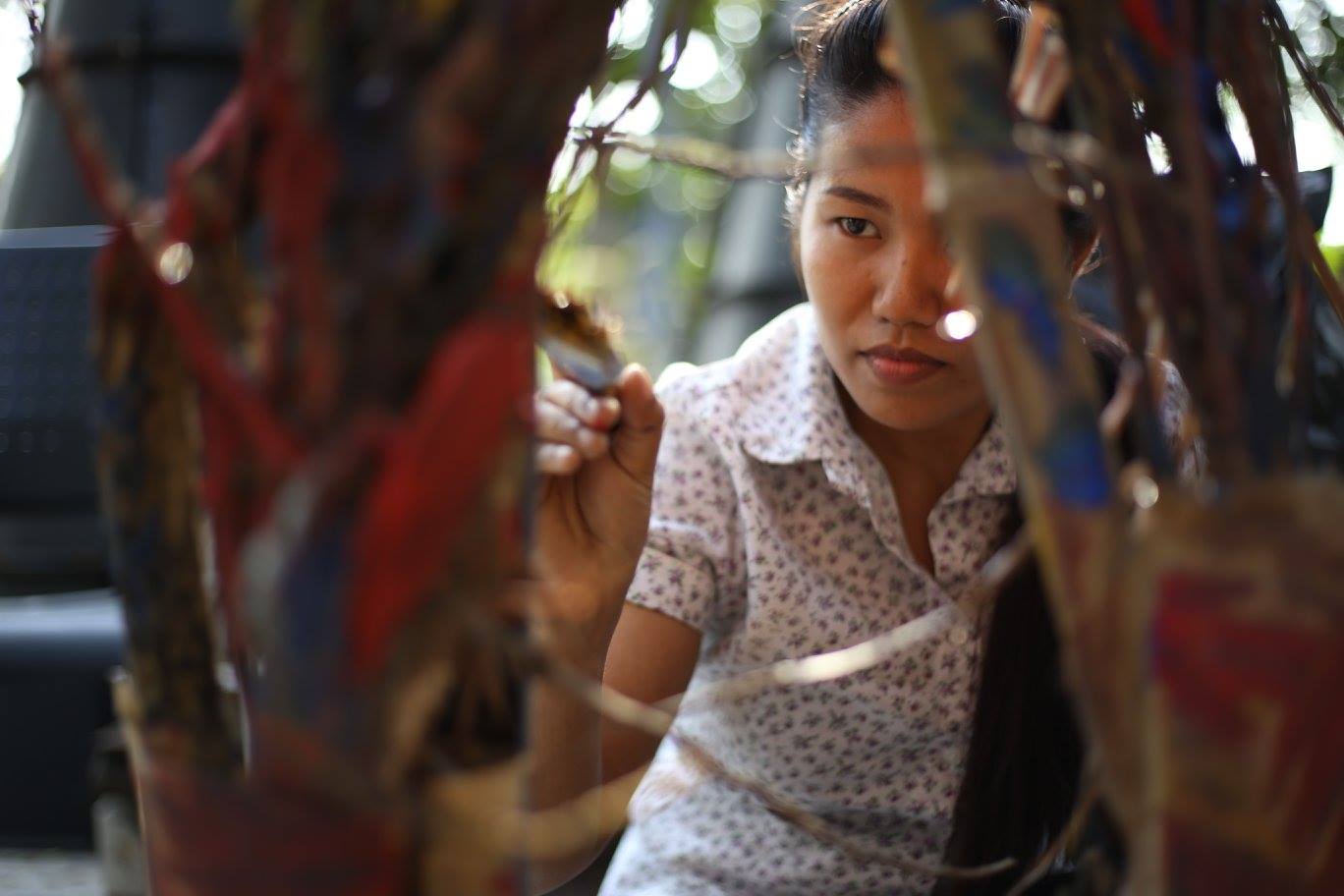
โครงการวิจัยและพัฒนาเชิงทัศนศิลป์ครั้งนี้อาศัยกระบวนการของการหลอมรวม โดยการสลายกรอบทางสังคม-ชุมชนที่เคยแบ่งแยก ให้กลับเข้าสู่หมวดการทดลองชุมชนร่วมกัน และเป็นการคลี่ออกของเศษส่วนที่ทับซ้อน เพื่อเผยพิกัดพื้นที่ภายในความหมายของการอยู่ร่วมกันและคุณค่าความเป็นมนุษย์ที่หลบซ่อนหรือแฝงเร้น ภายใต้กรอบคิดเชิงอำนาจแบบรัฐชาติ หน้าที่ของศิลปินและนักวิจัยในโครงการฯจึงไม่หยุดเพียงแค่การเชื่อมโยงสัมพันธ์ตนเองกับความเป็นสาธารณะเท่านั้น แต่การเผชิญหน้ากับความเป็นสาธารณะได้สร้างบทบาทผู้ส่งสารเชิงวิภาษต่อสถานการณ์ที่แวดล้อมด้วยสนามทางสังคม-การเมือง ทำให้ตัวโครงการฯสามารถเข้าใจได้ไม่ยากนักในฐานะสื่อศิลปะที่มีความสำคัญต่อแนวคิดทางสังคม-วัฒนธรรม และสุนทรียภาพเชิงความสัมพันธ์ระหว่างแรงงานชาวพม่าทั้ง 2 ท่านที่สมัครเข้าร่วมโครงการฯ จากการได้รับใบประกาศที่แจกจ่ายและกระจายไปในพื้นที่ชุมชนฯ เราไม่สามารถมองข้ามพวกเขาซึ่งมีส่วนสำคัญในฐานะผู้สร้างแผนที่โครงการ (Project mapping) ภายในกรอบความร่วมมือระยะเวลา 1 ปี โดยโครงการฯ เป็นผู้จัดหาที่พักอาศัยโดยไม่คิดค่าใช้จ่ายตลอดระยะเวลาโครงการฯ นี่จึงเป็นครั้งแรกที่แรงงานชาวพม่าทั้ง 2 ท่าน ออกจากพื้นที่ชุมชนทางกายภาพที่มีเขตแดนในอีกประเทศหนึ่ง เป็นชุมชนที่ซ้อนทับอยู่ภายในชุมชนอีกชั้นหนึ่ง การอยู่อย่างโดดเดี่ยวและไม่ปฏิสัมพันธ์กับมวลสมาชิกอื่นๆของชุมชน มีผลให้แรงงานอพยพที่มีความแตกต่างทางวัฒนธรรมปรับตัวเข้ากับสังคมที่ตนเองเข้ามาอาศัยไม่ได้ ความหวังที่มีต่อกรอบความคิดเรื่องการสร้างสรรค์พื้นที่ของการมีชีวิตร่วมกันของคนต่างวัฒนธรรม การสร้างความไว้เนื้อเชื่อใจทางวัฒนธรรมและการให้เกียรติเคารพยอมรับซึ่งกันและกันจะนำไปสู่การปรับตัวเข้าหากัน มีบทสนทนาต่อกันมากกว่าจะปะทะกันทางวัฒนธรรม การเปิดทางให้มีหรือสร้างบางอย่างร่วมกันเช่นนี้ ในท้ายที่สุดแล้วส่งผลให้ต่างฝ่ายต่างมีความเคารพในความต่างทางวัฒนธรรมของกันและกัน[4]
[1] Pascal Gielen & Pascal Gielen (eds.) – Community Art, The Politics of Trespassing: 2013 หน้า 20.
[2] Pascal Gielen & Pascal Gielen (eds.) :17.
[3] Pascal Gielen & Pascal Gielen (eds.) :19.
[4] ธเนศ วงศ์ยานนาวา – ความไม่หลากหลายของความหลากหลายทางวัฒนธรรม : 2557, หน้า 190.
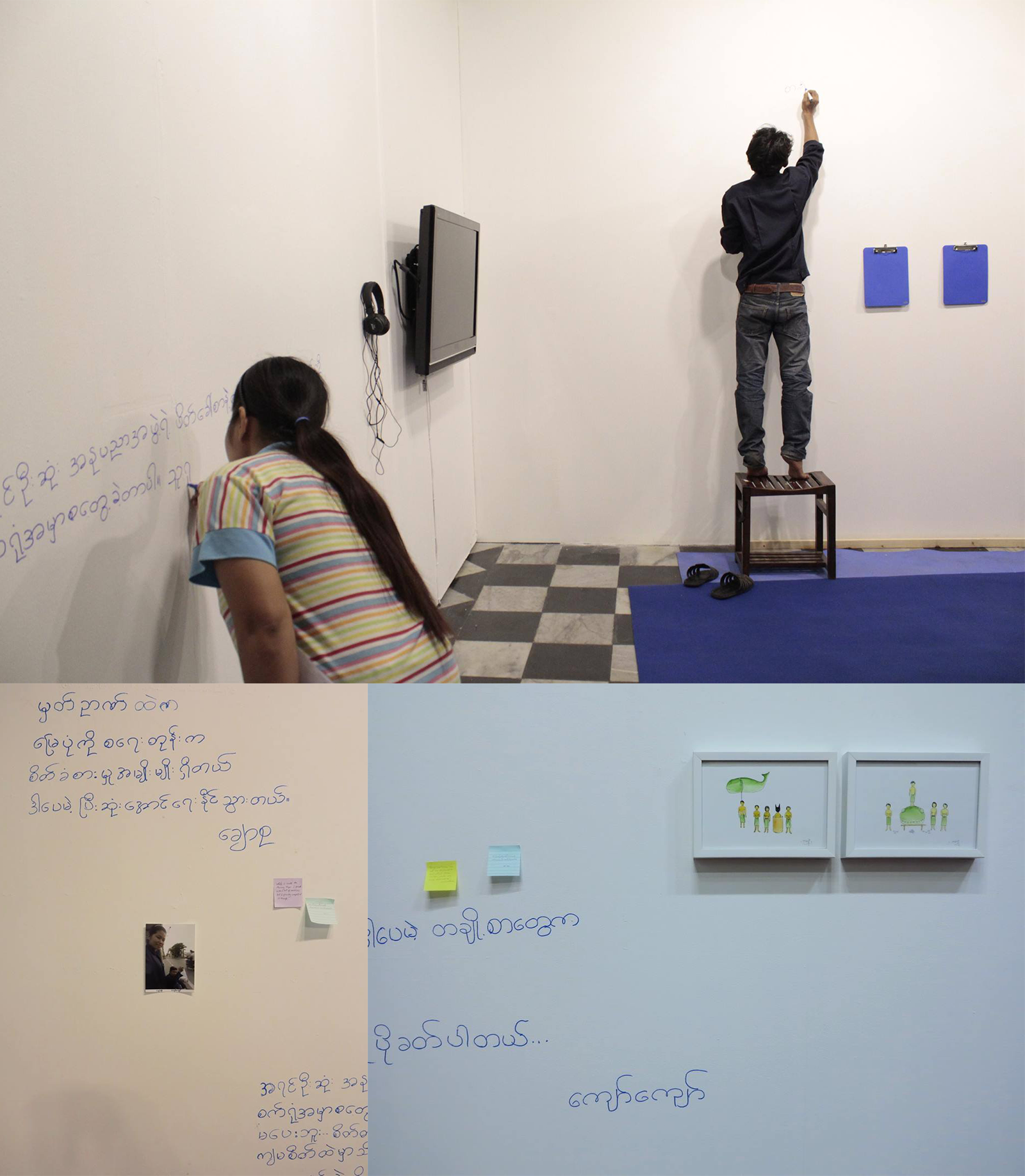
Chaw Su and Kyaw Moe
[365 Days: LIFE MUSE ] Project Mapping, 2016
365 days snapped photos, hand writing on wall, notebooks
In collaboration with : Nongpo community
ชอว์ สุ และ จอว์ โมว์
[365 Days: LIFE MUSE] แผนที่โครงการ, 2016
365 วัน ภาพถ่าย, เขียนมือบนผนัง, สมุดบันทึก
ร่วมมือกับ : ชุมชนหนองโพ
365 Days : LIFE MUSE Artist Interviews – Chaw Su and Kyaw Moe
https://www.youtube.com/watch?v=oL8o-4RSzv8
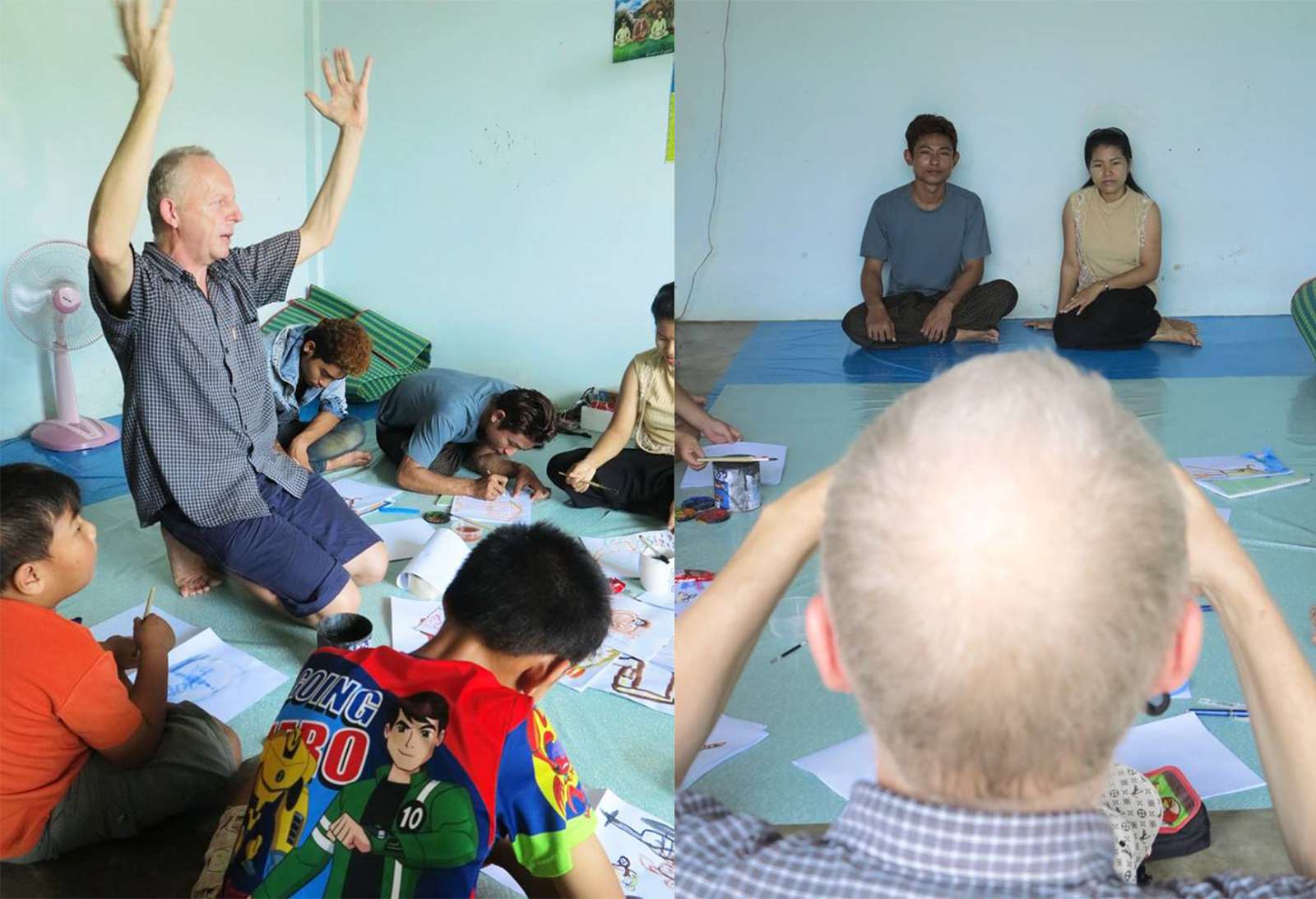
Alfred Banze
Artistic researcher project: Invisible, 2016
Collaborative drawings book with hand writing 25.5 x 27 cm, text on papers, clipboard, 31 x 22 cm each, 23 pages
In collaboration with : Chaw Su, Kyaw Moe, Zaw Zaw, Nooma Puengsawang, Chatmongkon Puengsawang, Chatchok Puengsawang, Suthida Palasu, Sopitcha Sripuek
อัลเฟรด บันซี
นักวิจัยเชิงทัศนศิลป์ในโครงการฯ: Invisible, 2016
วาดเส้นความร่วมมือและเขียนมือบนสมุด 25.5 x 27 ซม., บทความบนกระดาษ, คลิปบอร์ด, 31 x 22 ซม. ต่อแผ่น, 23 หน้า
ร่วมกับ : ซอว์ ซอว์, ชอว์ สุ, จอว์ โมว์, หนูมา พึ่งสว่าง, ฉัตรมงคล พึ่งสว่าง, ฉัตรโชค พึ่งสว่าง, สุธิดา พละสุ, โสภิชชา ศรีเผือก
365 Days : LIFE MUSE Artist Interviews – Alfred Banze
https://www.youtube.com/watch?v=PAc48PGwH00&t=8s
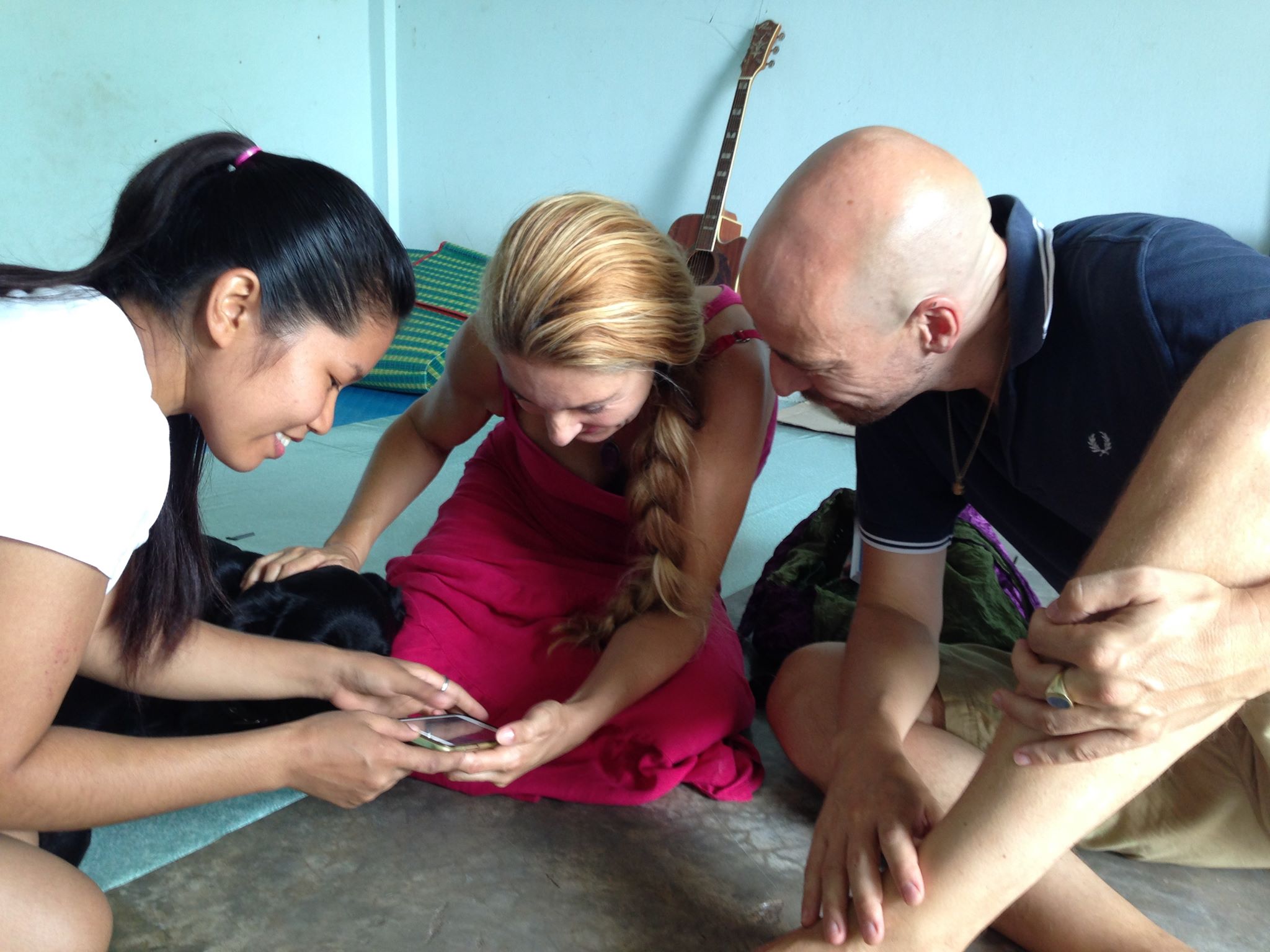
Jeanette Müeller, PhD.& Paul Divjak, PhD.
Artistic researcher project: May We Have Your Attention Please, 2016
Text on papers, clipboard, 31 x 22 cm each, 3 pages
In collaboration with : Chaw Su, Kyaw Moe
เจเนท มุลเลอร์ และ โพล ดีเวียค
นักวิจัยเชิงทัศนศิลป์ในโครงการฯ: กรุณาแสดงวิสัยทัศน์, 2016
บทความบนกระดาษ, คลิปบอร์ด, 31 x 22 ซม. ต่อแผ่น, 3 หน้า
ร่วมกับ : ชอว์ สุ, จอว์ โมว์
365 Days : LIFE MUSE Artist Interviews – Jeanette Mueller & Paul Divjak
https://www.youtube.com/watch?v=NsfTzXS7i50&t=19s
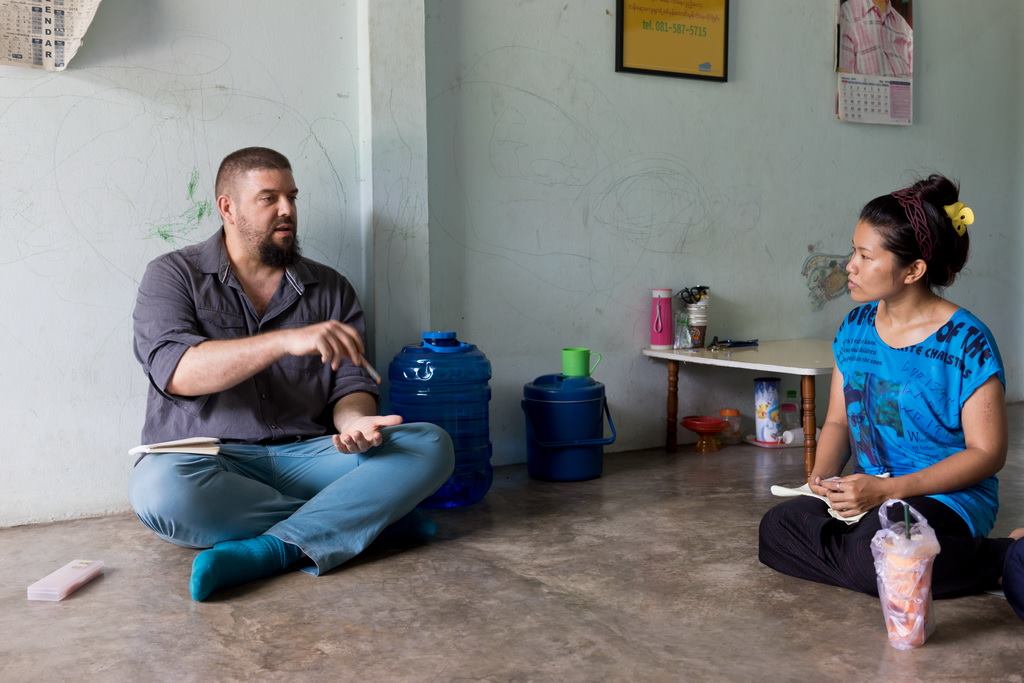
Sebastien Tayac PhD. Artistic researcher
Artistic researcher project: Micropolitics at Baan Noorg, 2016
Text on papers, clipboard, 31 x 22 cm each, 3 pages
In collaboration with : Chaw Su, Kyaw Moe
ดร. เซบาสเตียง ทายัค นักวิจัยเชิงทัศนศิลป์
นักวิจัยเชิงทัศนศิลป์: บ้านนอก-รัฐศาสตร์จุลภาค, 2016
บทความบนกระดาษ, คลิปบอร์ด, 31 x 22 ซม. ต่อแผ่น, 3 หน้า
ร่วมกับ : ชอว์ สุ, จอว์ โมว์
365 Days : LIFE MUSE Artist Interviews – Sebastien Tayac
https://www.youtube.com/watch?v=4b6_GIW4ILM&t=3s

Chi Yu Wu [Artist Support by Bamboo Curtain]
A private collection, 2016
Single-channel video, full HD, color, directional sound, 13 min 38 sec, loop
In collaboration with : Chaw Su, Kyaw Moe
ฉี ยวี่ หวู่ [ศิลปินสนับสนุนโดย Bamboo Curtain]
ของสะสมส่วนบุคคล, 2016
วีดีโอ-จอเดี่ยว, ความละเอียดสูง, สี, เสียง, 13 นาที 38 วินาที, วน
ร่วมมือกับ : ชอว์ สุ, จอว์ โมว์
365 Days : LIFE MUSE Artist Interviews – Wu Chi Yu
https://www.youtube.com/watch?v=FCIPAQVmo6o&t=10s
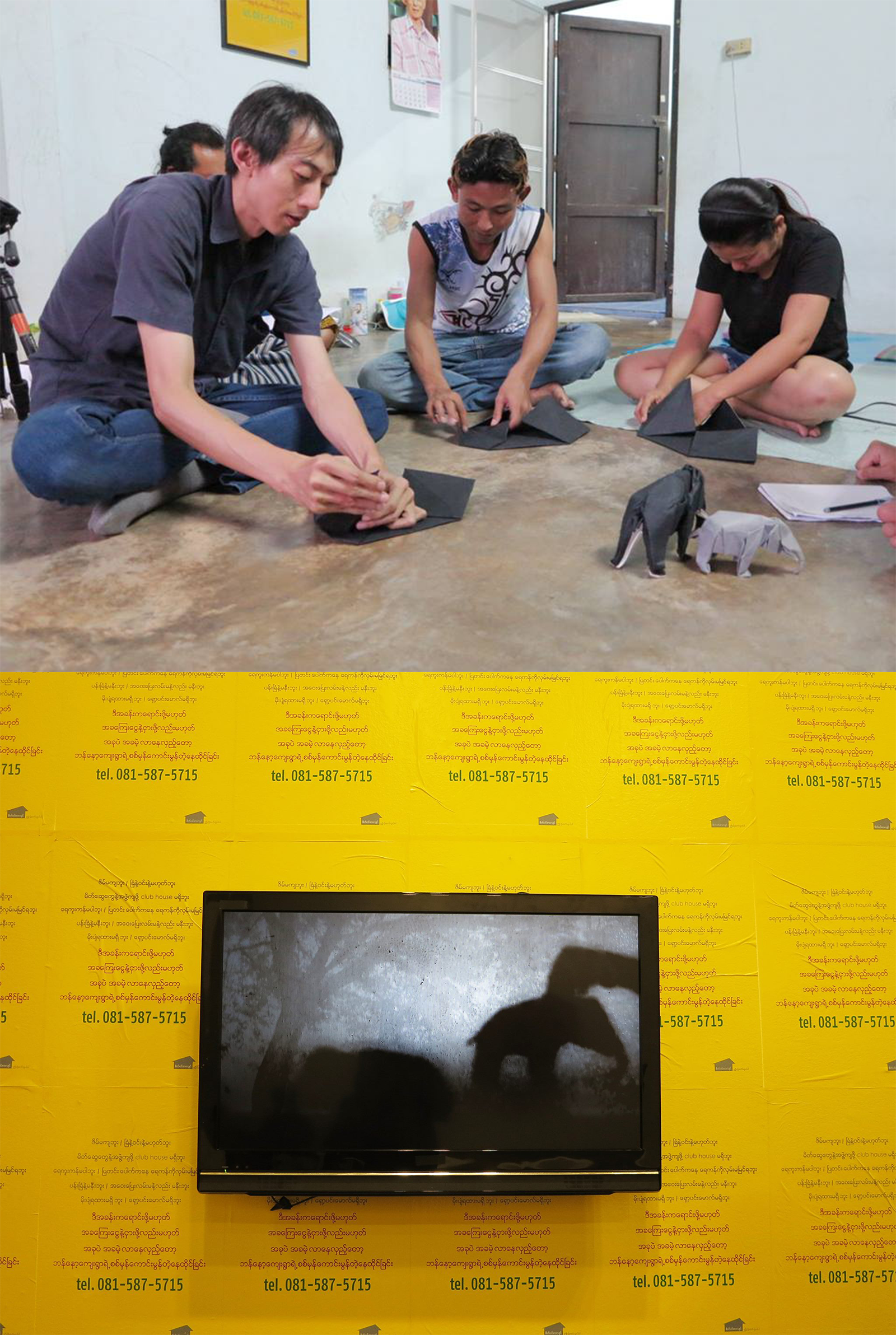
Chia Jen Chen [Artist Support by Open Contemporary art center]
Unfolding, 2016
Video, full HD, b&w, mute, 7 min 41 sec, loop
In collaboration with : Chaw Su, Kyaw Moe
เจีย เริ่น เฉิน [ศิลปินสนับสนุนโดย Open Contemporary Art Center]
คลี่, 2016
วีดีโอ, ความละเอียดสูง, ขาว-ดำ, เงียบ, 7 นาที 41 วินาที, วน
ร่วมกับ : ชอว์ สุ, จอว์ โมว์
365 Days : LIFE MUSE Artist Interviews – Chia Jen Chen
https://www.youtube.com/watch?v=PkuB183NBuY&t=11s

Helmi Hardian and Tuwis Yasinta [WAFT LAB Representatives]
Mai Pen Rai, 2016
Microcontroller, electronic circuit, active speaker, conductive paint, plywood board, rotan, 130 x 110 cm
In collaboration with : Pra-ajarn Siratecha, Chaw Su, Kyaw Moe
เฮลมี ฮาร์เดียน และทวิส ยาซินตา [ตัวแทนจาก WAFT-LAB]
ไม่เป็นไร, 2016
อุปกรณ์ควบคุมขนาดเล็ก, วงจรไฟฟ้า, ลำโพงแอ็คทีฟ, สีนำไฟฟ้า, กระดานอัด, เส้นหวาย, 130 x 110 ซม.
ร่วมมือกับ : พระอาจารย์ ศิระเตชะ, ชอว์ สุ, จอว์ โมว์
365 Days : LIFE MUSE Artist Interviews – Waft Lab
https://www.youtube.com/watch?v=tIv2wXAO-BQ&t=8s
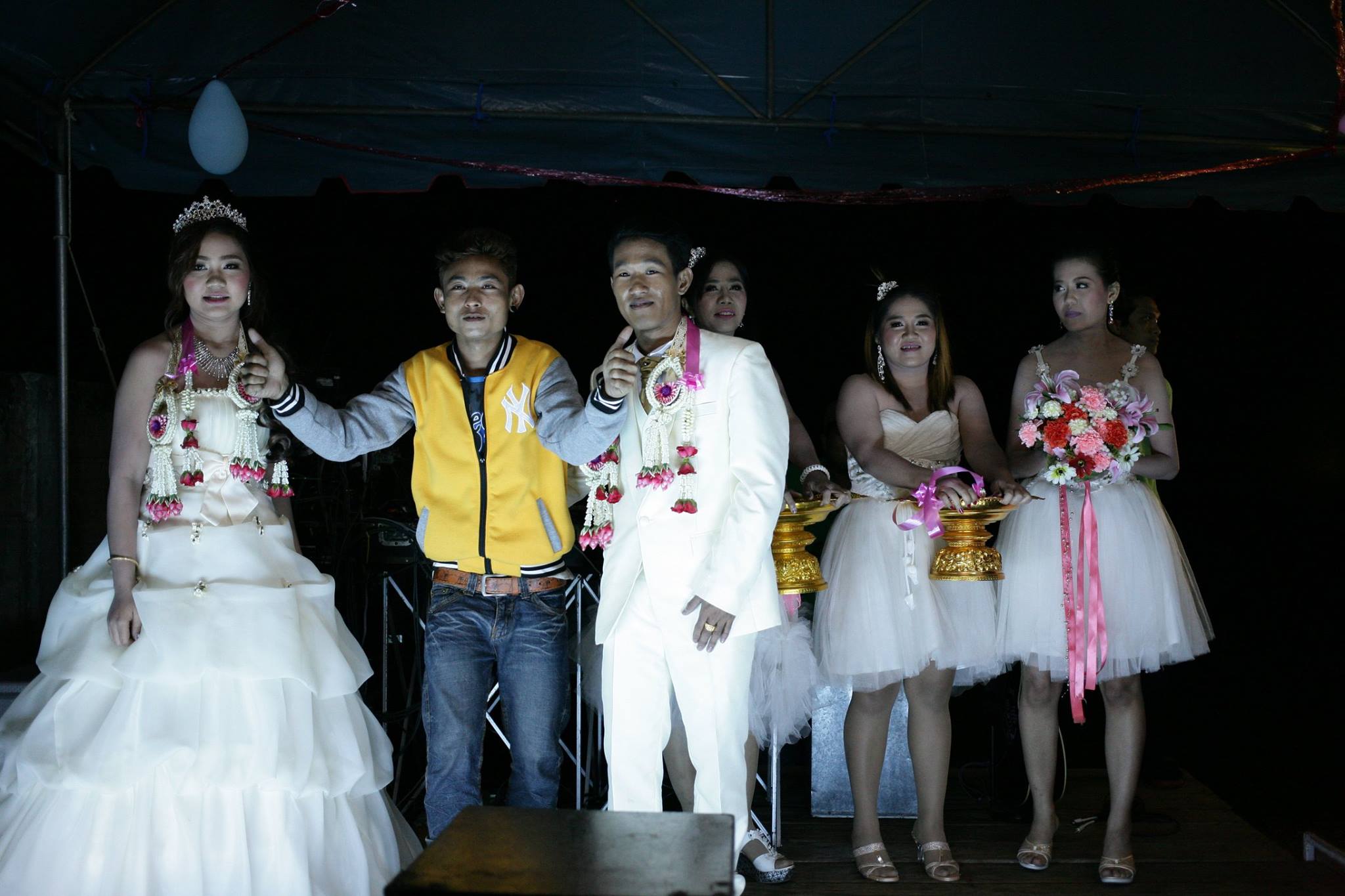
Henry Tan
I Love Thailand and Live Here Many Many Years, 2016
The series of sound installation : Journey / Rest / Dream. Text on paper, 10 x 7.5 cm, Mp3, speakers, sound, 2 min 13 sec / 8 min 43 sec / 2 min 25 sec
In collaboration with : Chaw Su, Kyaw Moe, Khin Nawe, Thein Soe
เฮนรี แทน
ผมรักเมืองไทยและมาอยู่เมืองไทยหลายปีหลายปี, 2016
ชุดเสียงจัดวาง : เดินทาง / พัก / ฝัน บทความบนกระดาษ, 10 x 7.5 ซม., Mp3, ชุดลำโพง, เสียง, 2 นาที 13 วินาที / 8 นาที 43 วินาที / 2 นาที 25 วินาที
ร่วมมือกับ : ชอว์ สุ, จอว์ โมว์, เคน นอว์ย, เตง โซว์
365 Days : LIFE MUSE Artist Interviews – Henry Tan
https://www.youtube.com/watch?v=82_q64vF9-c

Jutamas Buranajade & Piti Amraranga
Saponification Case, 2016
Beaker, petri dish, laboratory bottle, pH test strip, palm oil, coconut oil, rice bran oil, milk, thanaka
powder, sodium hydroxide, soap, soap making mold, soap cutting block, instax mini photo, table 240 x 60 x 75 cm
In collaboration with : Chaw Su, Kyaw Moe, Soe Htite Oo, Zaw Zaw, Montri Charoenraksa Dairy farm, Somtob Pinpetch Dairy farm, Somjit Noopitak Dairy farm
จุฑามาส บูรณะเจตน์ และ ปิติ อัมระรงค์
กรณี ซาพอนนิฟิเคชัน, 2016
บีกเกอร์, จานเพาะเชื้อ, ขวดทดลอง, กระดาษวัดค่า pH, น้ำมันปาล์ม, น้ำมันมะพร้าว, น้ำมันรำข้าว, น้ำนม, ผงทานาคา, โซดาไฟ, สบู่, แม่พิมพ์สบู่, แท่นตัดสบู่, รูปโพลาลอยด์, โต๊ะ, 240 x 60 x 75 ซม.
ร่วมกับ : ชอว์ สุ, จอว์ โมว์, โซ ไทท์ อู, ซอว์ ซอว์, ฟาร์มโคนมคุณสมจิตต์ หนูพิทักษ์, ฟาร์มโคมนมคุณมนตรี เจริญรักษา, ฟาร์มโคนมคุณสมทบ พิมพ์เพชร
365 Days : LIFE MUSE Artist Interviews – Henry Tan
https://www.youtube.com/watch?v=Xnp7_P4QWqg

Katherine Nuñez [98B COLLABoratory representative]
Getting to Know You, 201.
Rubbing on paper, graphite, light-box, 90 x 200 x 31.5 cm
In collaboration with : Chaw Su, Soe Htite Oo, Zaw Zaw, Kyaw Moe, Bo Bo
แคเธอรีน นูเนซ [ตัวแทนจาก 98B COLLABoratory]
เพื่อรู้จักคุณ, 2016
คัดลอกพื้นผิวบนกระดาษ, ดินสอตะกั่วดำ, กล่องไฟ, 90 x 200 x 31.5 ซม.
ร่วมมือกับ :ชอว์ สุ, จอว์ โมว์, โซ ไทท์ อู, ซอว์ ซอว์, โบ โบ
365 Days : LIFE MUSE Artist Interviews – Katherine Nunez
https://www.youtube.com/watch?v=4GUErFl5eKw&t=22s

Korakrit Arunanondchai
The Hug, 2016
Found objects, metal, denim, paint, 200 x 190 x 90 cm, digital print photo, color, 29.5 x 21 cm
In collaboration with: Chaw Su, Kyaw Moe, Zaw Zaw
กรกฤต อรุณานนท์ชัย
กอด, 2016
เศษวัสดุ, เหล็ก, ผ้าเดนิม, ระบายสี, 200 x 190 x 90 ซม., พิมพ์ภาพถ่ายดิจิตอล, สี, 29.5 x 21 ซม.
ร่วมมือกับ: ชอว์ สุ, จอว์ โมว์, ซอว์ ซอว์
365 Days : LIFE MUSE Artist Interviews – Korakrit Arunanondchai
https://www.youtube.com/watch?v=oyuZH51qdzU&t=13s

Ma Ei
Asean, 2016
digital print photo, color, 100 x 280 cm, metal stand 125 x 172 cm
In collaboration with : Htet Htet Phyo, Myat Noe, Daw Haing Kyin, Daw Kyin Mya, Mee Zin, San San Wai, Mee Nan, Mee Chaw, Nyo Nyo San, Thida San, Kan Kan, Soe Htite Oo, Chaw Su, Kyaw Moe
มา อิ
อาเซียน, 2016
พิมพ์ภาพถ่ายดิจิตอล, สี, 100 x 280 ซม., โครงเหล็ก 125 x 172 ซม.
ร่วมมือกับ : เท็ท เท็ท ผโย, มเยียต โน, ดอว์ ไฮ่ง์ จี้น, ดอว์ จีน มเยียะ, มี ซิน, ซาน์ ซาน์ เว, มี นาน์, มี ชอว์, นโย นโย ซาน์, ธีดา ซาน์, กั่น กั่น, โซ ไทท์ อู, ชอว์ สุ, จอว์ โมว์
365 Days : LIFE MUSE Artist Interviews – Ma Ei
https://www.youtube.com/watch?v=ILwwstd9ysw&t=9s

Masaru Iwai
Motorcycle Washing, 2016
Single-channel full HD video, color, sound, 10 min 40 sec, loop
In collaboration with : Kyaw Moe, Soe Htite Qo, Nyl Nyl Zow, Zaw Zaw, Lu Aye, Kyaw Kyaw, Ku Lar, San Aung, Saralok Eurkcheua, Kyaw Oo, Nge Lay, Thar Nge Lay
มาซารุ อิวาอิ
การชำระล้างจักรยานยนต์, 2016
วีดีโอ-จอเดี่ยว ความละเอียดสูง, สี, เสียง, 10 นาที 40 วินาที, วน
ร่วมมือกับ : จอว์ โมว์, โซ ไทท์ อู, น์งี น์งี ซอว์, ซอว์ ซอว์, ลู อเย, จอว์ จอว์, กัน ลาร์, ซาน์ เอาง์, สรลักษณ์ เอิกเชื้อ, จอว์ อู, แหง่ เลย์, ธาร์ แหง่ เลย์
365 Days : LIFE MUSE Artist Interviews – Masaru Iwai https://www.youtube.com/watch?v=QiIjVsvjCEQ

Maung Day
The Belly of a Stranded Giant Fish Opens Up, 2016 and The series of: Migrating Whale 1-2, 2016
Poem on vinyl sticker, 59.4 x 84.1 cm, watercolors on paper, 21 x 29.5 cm each
In collaboration with : Chaw Su, Kyaw Moe
เมาง์ เดย์
พุงของปลาตัวมหึมาได้เปิดออก, 2016 และ ชุดภาพ: วาฬอพยพ 1-2, 2016
ร่วมกับ : ชอว์ สุ, จอว์ โมว์
บทกวีบนไวนิลสติกเกอร์, 59.4 x 84.1 cm, สีน้ำบนกระดาษ,21 x 29.5 ซม. ต่อชิ้น
365 Days : LIFE MUSE Artist Interviews – Maung Day
https://www.youtube.com/watch?v=BcFnxIY3TLo

Okui Lala
How Do We Meet? How Can We Meet? I&II, 2016
Three-channel video, color, sound, headphone, 3 min 12 sec (left-right), 1 min 06 sec, loop, text on paper, 21 x 29.5 cm
In collaboration with : Chaw Su, Kyaw Moe, Seng-im Saeton, Maneerat Khananukul
โอกุย ลาลา
เราพบกันอย่างไร เราจะสามารถพบกันได้อย่างไร I&II, 2016
วีดีโอ 3 จอ, สี, เสียง, 3 นาที 12 วินาที (ซ้าย-ขวา), หูฟัง, 1 นาที 06 วินาที, วน, บทความบนกระดาษ, 21 x 29.5 ซม.
ร่วมมือกับ : ชอว์ สุ, จอว์ โมว์, เซ็งอิม แซ่ตั้น, มณีรัตน์ คณานุกูล
365 Days : LIFE MUSE Artist Interviews – Okui Lala
https://www.youtube.com/watch?v=vrWCFeByxMI

Preenun Nana
Root, 2016
Plants, wood stand, single-channel video, b&w, sound, headphone, 4 min 6 sec, loop
In collaboration with : Ampan Leelakongkrapan, Chaw Su, Kyaw Moe
ปรีณัน นานา
ราก, 2016
พืช-สมุนไพร, โครงไม้, วีดีโอ-จอเดี่ยว, ขาว-ดำ, เสียง, หูฟัง, 4 นาที 6 วินาที, วน
ร่วมมือกับ : อำพัน ลีลาคงกระพันธ์, ชอว์ สุ, จอว์ โมว์
365 Days : LIFE MUSE Artist Interviews – Preenun Nana
https://www.youtube.com/watch?v=j3ZIbO7sWng

Rachan Klomklieng
A Home in the Heart, 2016
Spray paint, 500 x 300 cm
In collaboration with : Chaw Su, Kyaw Moe
ราชันย์ กล่อมเกลี้ยง
บ้านในใจ, 2016
พ่นสี, 500 x 300 ซม.
ร่วมมือกับ : ชอว์ สุ, จอว์ โมว์
365 Days : LIFE MUSE Artist Interviews – Rachan Klomklieng
https://www.youtube.com/watch?v=p-hYRbU2d6Q&t=171s

Suraporn Lertwongpaitoon
For True Living, 2016
Poster, 42 x 59.4 cm each, 42 pcs.
สุรพร เลิศวงศ์ไพฑูรย์
เพื่อความเป็นอยู่ที่แท้จริง, 2016
ใบประกาศ, 42 x 59.4 ซม. ต่อแผ่น, 42 แผ่น
365 Days : LIFE MUSE Artist Interviews – Suraporn Lertwongpaitoon
https://www.youtube.com/watch?v=nxE5yo36BUc&t=37s

Thatchatham Silsupan
Taung Tae Su Nae Pyae Wa Ya Say Thar, 2016
45 paper speakers, amplify, sound, 3 min 10 sec, loop
In collaboration with : Chaw Su, Kyaw Moe, Zaw Zaw, Siwat Maksuwan
ธัชธรรม ศิลป์สุพรรณ
เตาง์ เทะ สุ เนะ ปิ วา ยา เซย์ ตาร์, 2016
45 ลำโพงกระดาษ, เครื่องขยาย, เสียง, 3 นาที 10 วินาที, วน
ร่วมมือกับ : ชอว์ สุ, จอว์ โมว์, ซอว์ ซอว์, ศิวัช เมฆสุวรรณ์
365 Days : LIFE MUSE Artist Interviews – Thatchatham Silsupan
https://www.youtube.com/watch?v=_zk6OQRlZqE&t=34s

Varsha Nair
Memory Maps, 2016
Collaborative drawing on bai larn (palm-leaf), pencil, ink, egg tempera, 72 x 7 cm each, 22 pcs., text on paper, 21 x 29.5 cm each, 12 pages
In collaboration with : Pramaha Somkit Adhasittho, Chaw Su, Kyaw Moe, Supaporn Meemalai, Suthep Boonprasop, Maneerat Khananukul, Noogim Srisamut, Kanthana Marod, Chatmongkon Puengsawang, Chatchok Puengsawang, Suthida Palasu, Lakshmi.
วาร์ชา แนร์
แผนที่ในทรงจำ, 2016
ความร่วมมือวาดเส้นและเขียนมือบนใบลาน, ดินสอ, หมึก, สีฝุ่นเทมเพอรา, 72 x 7 ซม. ต่อแผ่น, 22 แผ่น, บทความบนกระดาษ, 21 x 29.5 ซม. ต่อแผ่น, 12 หน้า
ร่วมมือกับ : พระมหาสมคิด อตถฺสิทฺโธ, ชอว์ สุ, จอว์ โมว์, สุภาภรณ์ มีมาลัย, สุเทพ บุญประสพ, มณีรัตน์ คณานุกูล, หนูกิม ศรีสมุทร, กัญฐนา มารอด, ฉัตรมงคล พึ่งสว่าง, ฉัตรโชค พึ่งสว่าง, สุธิดา พละสุ, ลักษมี
365 Days : LIFE MUSE Artist Interviews – Varsha Nair
https://www.youtube.com/watch?v=DISVGqqchvw&t=20s

OCAC Observation Team [Support by Open Contemporary Art Center]
OCAC Observation Team : Shih Tung Lo, Yun Ju Chou, Zi Ming Feng , Rikey Tenn-No Man’s land
365 d Archive
365 d Archive diary
The OCAC Observation Team is a network’s collaborative group specially formed for this project. The team included artists and writers who have gathered information and selected significant content such as document, references, photos, interviews, sound, etc., to create timeline and portray the referring content including the essence of the experiment from the community collaboration between Myanmar labours, villagers, artists and project organizers within 365 days of time frame. The result of the work was recorded in the form of a calendar diary along with an exhibited installation of the 365 D Archive. The chronicle archives which were attained through surveying and researching revealed the social and cultural development of the Myanmar labours who have participated in the 365 Days: LIFE MUSE project including the progress of learning of the co-existence under the cultural diversity in Nong Po community. The record of the events, in the form of calendar diary by the OCAC Observation Team, was created through the notion of the process of investigation and extended results of the overview of the whole project toward the perspective of Myanmar labours, community, artists and project organizers. This allowed the audience to chronologically reach the information that disclosed the content stated by Myanmar labours, expressing their feelings, relationship and transformation that have occurred throughout the past 1 year.
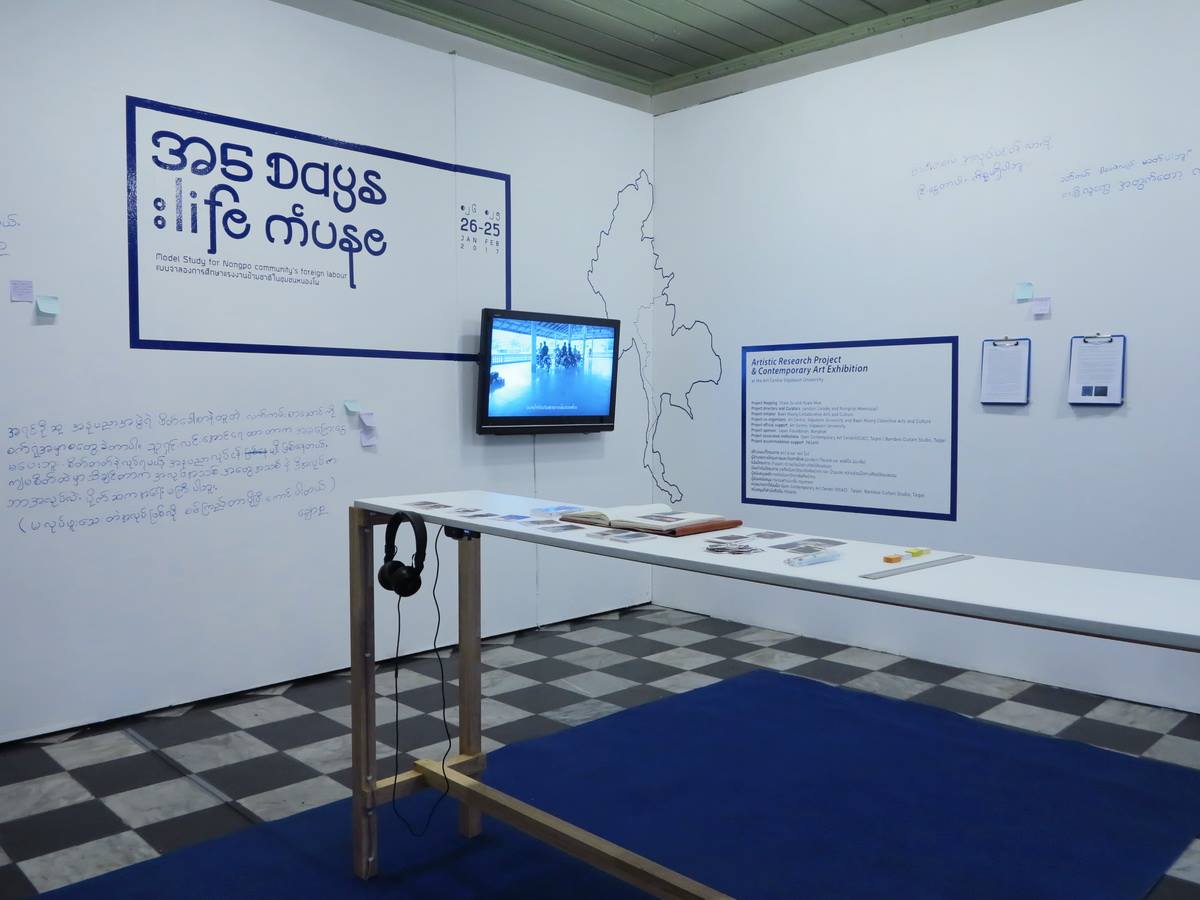
คณะสังเกตการณ์ OCAC : ซื่อ ตง โล, ยวิ่น หยู โจว, จื้อ หมิง เฟิง, ไรคี่ เจิ้ง-No Man’s land
365 d บันทึก
สมุดบันทึกประจำวัน
คณะสังเกตการณ์ OCAC (ocac observation team) คือกลุ่มความร่วมมือของเครือข่ายที่จัดตั้งขึ้นเฉพาะกิจ เป็นการทำงานร่วมกันระหว่างศิลปินและนักเขียนเพื่อเก็บ รวบรวมข้อมูล คัดสรรตัวบทต่างๆ อาทิ เอกสาร อ้างอิง ภาพถ่าย บทสัมภาษณ์ถามตอบ เสียง ฯลฯ เพื่อนำเสนอลำดับเหตุการณ์และแสดงตัวบทอ้างอิงความเคลื่อนไหว และความหมายของการมีส่วนร่วมในการทดลองชุมชนระหว่างแรงงานชาวพม่า ชาวบ้านท้องถิ่น ศิลปิน รวมถึงคณะผู้ดำเนินงานโครงการฯ ตามกรอบระยะเวลา 365 วัน ด้วยรูปแบบของสมุดปฏิทินบันทึกประจำวัน และการจัดแสดงผลบันทึกข้อมูลเหล่านั้นในรูปแบบศิลปะจัดวางภายในพื้นที่ส่วนจัดแสดง 365 d Archive การสำรวจขุดค้นและบันทึกอย่างเป็นลำดับเวลา ได้แสดงให้เห็นถึงพัฒนาการทางสังคมวัฒนธรรมของแรงงานชาวพม่าที่เข้าร่วมโครงการ 365 Days: LIFE MUSE และพัฒนาการการเรียนรู้ เพื่อการอยู่ร่วมกันภายใต้ความหลายหลายทางวัฒนธรรมในชุมชนหนองโพ ลำดับเวลาดังกล่าวแสดงออกในรูปลักษณะของสมุดปฏิทินบันทึก ซึ่งคณะสังเกตการณ์ OCAC มีแนวคิดเชิงสอบสวนและขยายผลภาพรวมของโครงการฯ ผ่านมุมมองของแรงงานชาวพม่า ชุมชน ศิลปินและผู้ดำเนินโครงการฯ เปิดพื้นที่ให้ผู้ชมเข้าถึงข้อมูลอย่างเป็นลำดับ เผยตัวบทอ้างอิงคำพูดจากแรงงานชาวพม่าซึ่งสะท้อนความรู้สึกความสัมพันธ์และการเปลี่ยนแปลงที่เกิดขึ้นตลอดระยะเวลา 1 ปีที่ผ่านมา
Artistic Research Project & Contemporary Art Exhibition
365 Days: LIFE MUSE (Model Study for Nongpho Community’s Foreign Labourers)
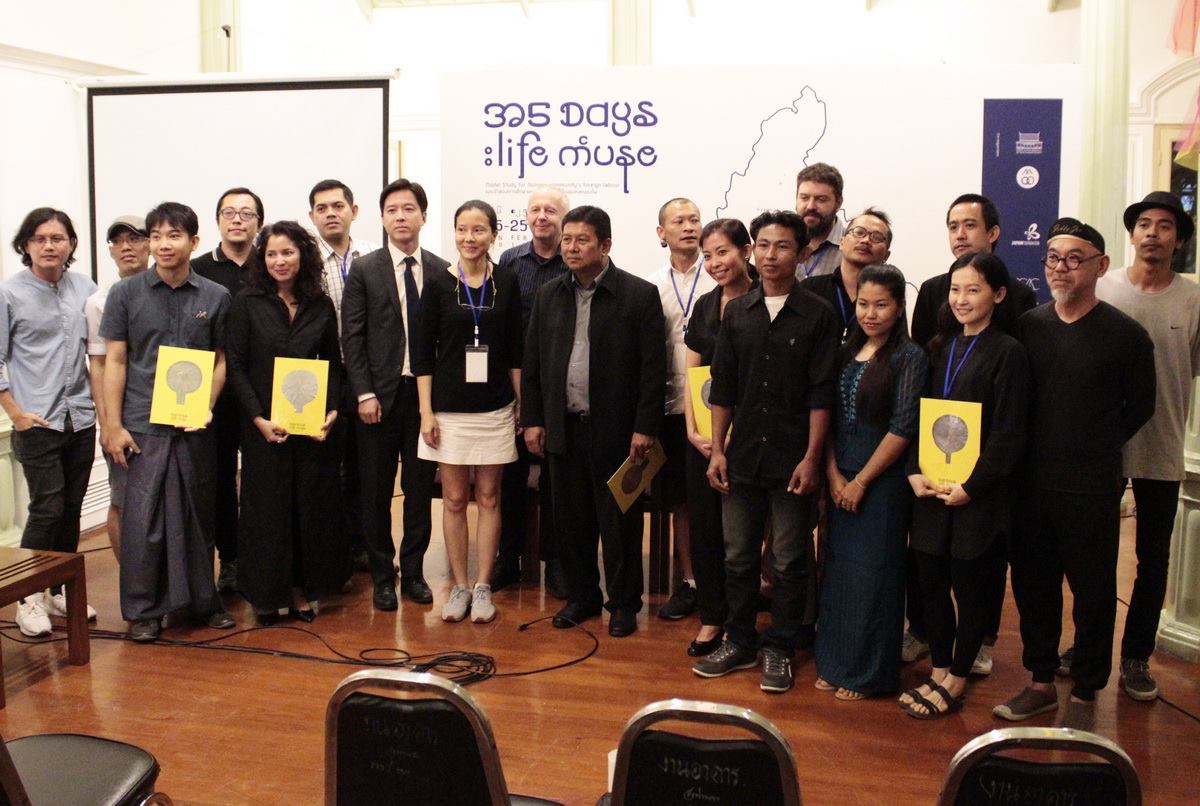 365 Days : LIFE MUSE / Opening ceremony 26 January 2017
365 Days : LIFE MUSE / Opening ceremony 26 January 2017
 Live sound performance by Rachan klomklieng, vs Hyper Allergic sub (Waft Lab), on the opening of 365 Days : LIFE MUSE
Live sound performance by Rachan klomklieng, vs Hyper Allergic sub (Waft Lab), on the opening of 365 Days : LIFE MUSE
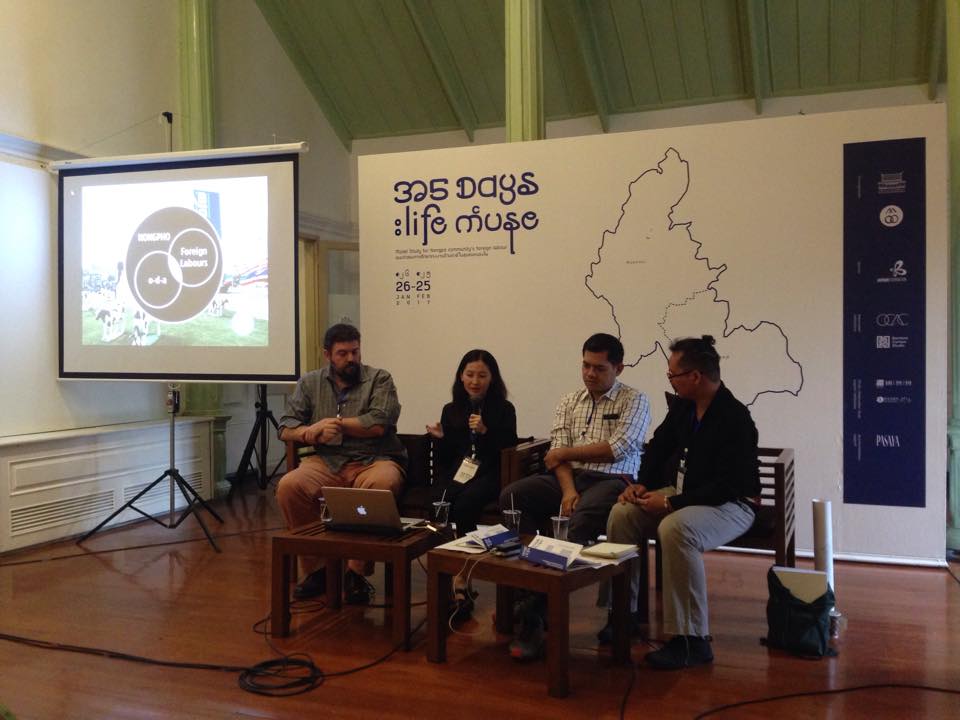
Opening Forum
Forum by Worathep Akkabootara
Speaker : Sabastien Tayac, Siwawong Suktawee, Jithamas Buranajade
Date: 26 January 2017
Venue: Art Centre Silpakorn University
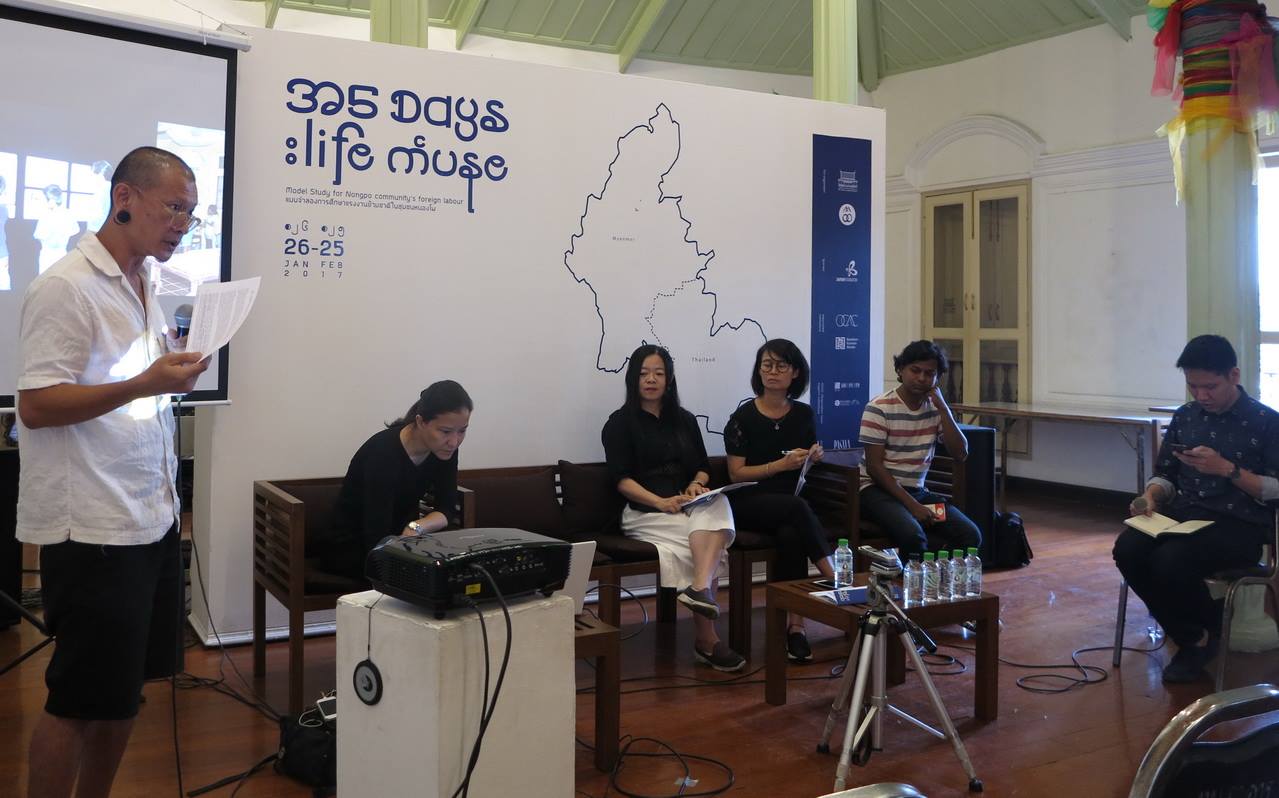
Closing Forum
ศิลปะชุมชนเป็นปัญหา?
Is Community-Based Art Problematic?
Speaker :
Frankie Su, director of Honggah Museum, Taipei (TW)
Maung Day, Artist, poet, NGO, 365 Days: LIFE MUSE participated artist (MM)
Sandy Hsiu-chih Lo, independent curator, art critic and film maker (TW)
Sakarin Krue-On, Board of committee of Baan Noorg Collaborative Arts and Culture (TH)
Moderators: jiandyin (Jiradej and Pornpilai Meemalai), curators of 365 Days: LIFE MUSE project.
Date: 25 February 2017
Venue: Art Centre Silpakorn University
 Article on Bangkokbiznews by Chathip Suwanthong
Article on Bangkokbiznews by Chathip Suwanthong
Jud Pra Kai, 22 Dec 2016
Article on Art 4 D: THE STORIES OF OTHERS by Napat Charitbutra
1 April 2017
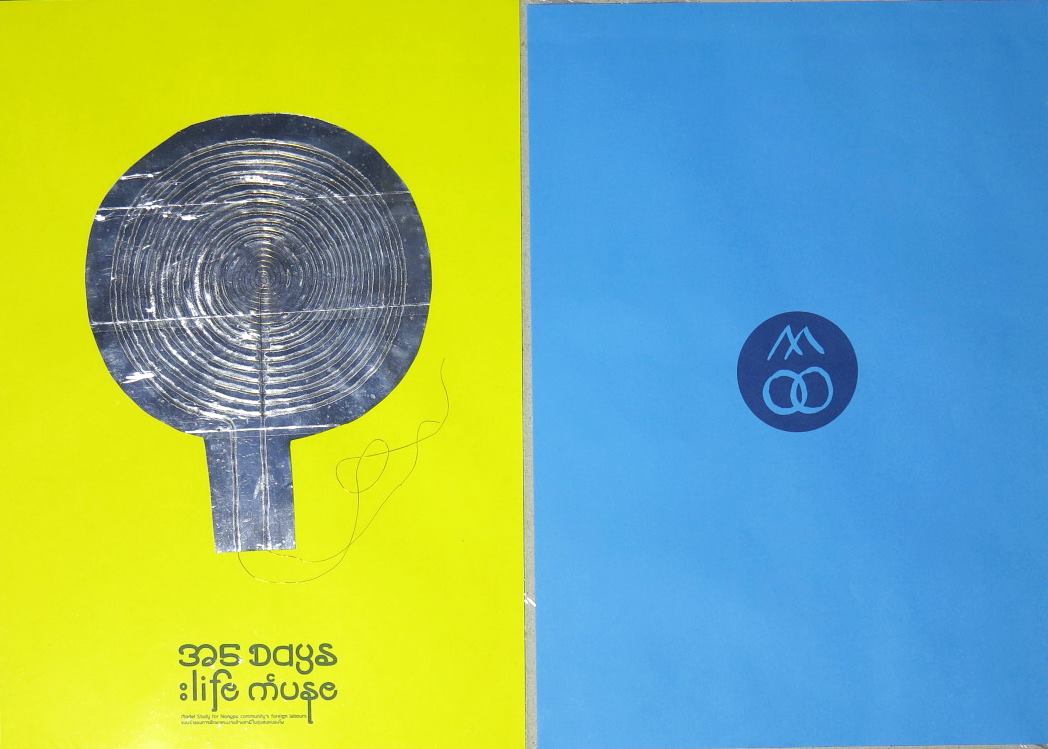 365 D’s complimentary gifts for honorary guests and contributors on occasion of the exhibition opening on 26-1-2016.
365 D’s complimentary gifts for honorary guests and contributors on occasion of the exhibition opening on 26-1-2016.
365 Days: LIFE MUSE (Model Study for Nongpho Community’s Foreign Labourers)
Opening Exhibition:
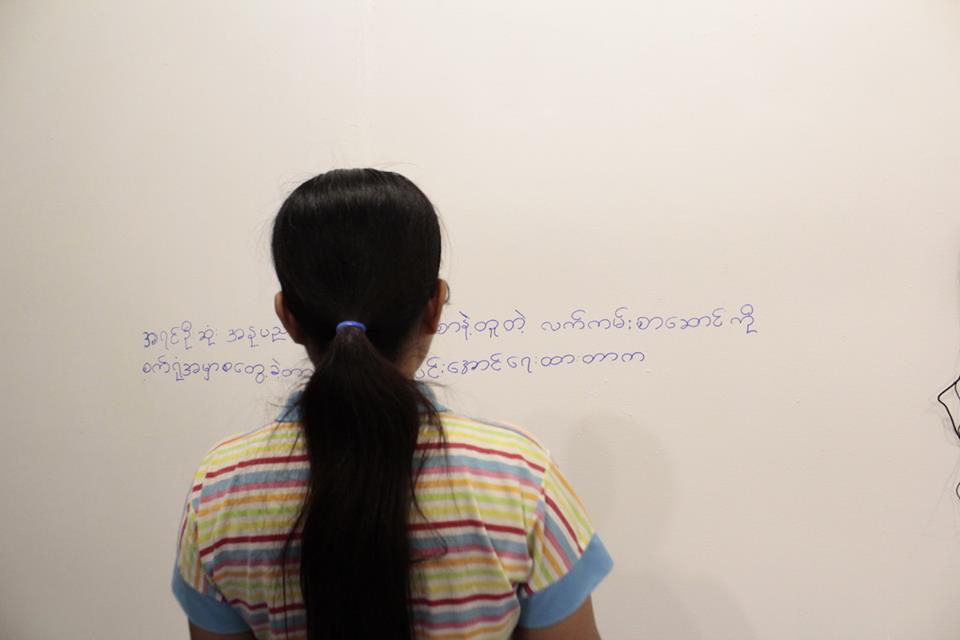 Chaw Su: Project Mapping
Chaw Su: Project Mapping
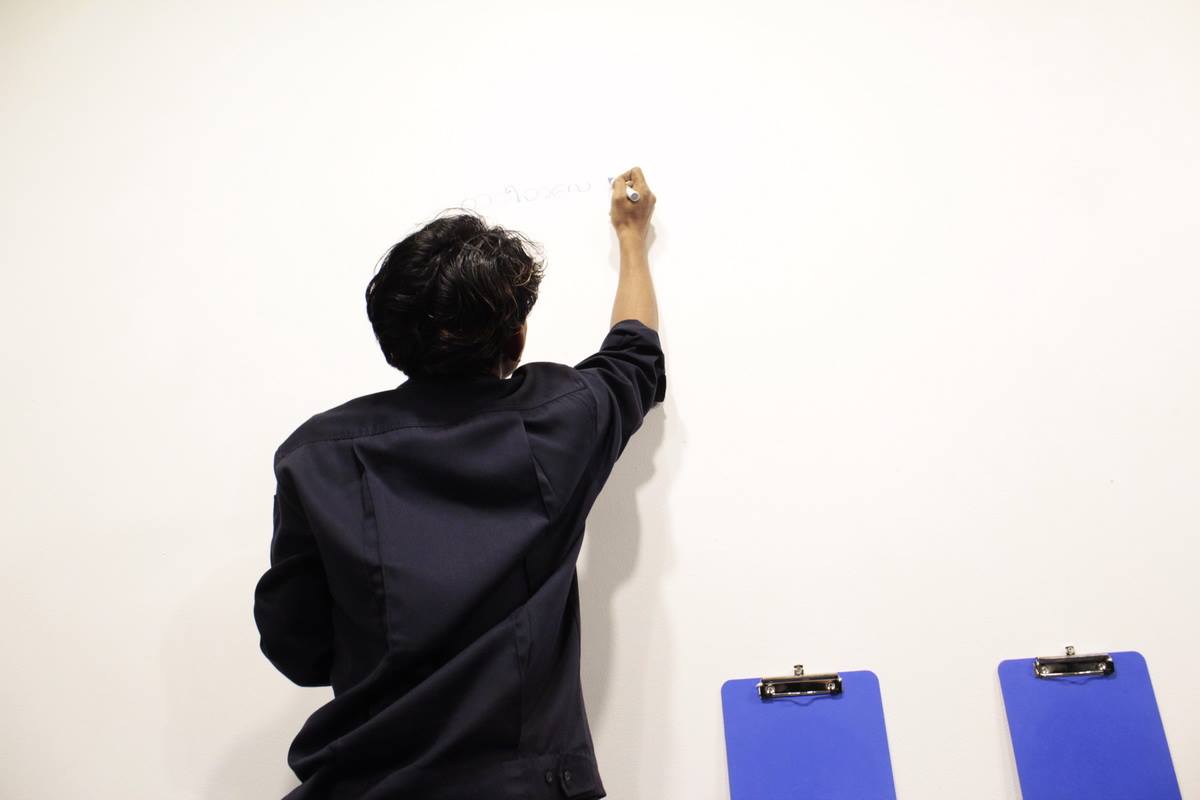 Kyaw Moe: Project Mapping
Kyaw Moe: Project Mapping

